Recent Advances in DSP Techniques for Mode Division Multiplexing Optical Networks with MIMO Equalization: A Review
Abstract
1. Introduction
2. Principle
2.1. MIMO Equalizers: State of the Art
2.2. LMS and RLS Techniques
2.3. STBC-Assisted RLS Algorithms
2.4. Polarization-Related Dynamic Equalization
2.5. OFDM FDE Requirements
2.6. MIMO Hardware Requirements
3. System Configuration
4. Performance Evaluation for Different Adaptive Filtering Schemes
5. STBC-Assisted Improvement between Various Modulation Formats
6. MIMO Equalization for Mode-Dependent Loss
7. Hardware Complexity Optimization for MIMO
7.1. Filter Tap Number for MIMO
7.2. Single-Stage Architecture
7.3. Joint DSP for MCF-Based SDM
8. Recent Experiments of SDM Transmission Using FMFs
9. Conclusions
Author Contributions
Funding
Acknowledgments
Conflicts of Interest
References
- Winzer, P.J. Making spatial multiplexing a reality. Nat. Photonics 2014, 8, 345–348. [Google Scholar] [CrossRef]
- Li, A.; Chen, X.; Amin, A.A.; Ye, J.; Shieh, W. Space-division multiplexed high-speed superchannel transmission over few-mode fiber. J. Lightw. Technol. 2012, 30, 3953–3964. [Google Scholar] [CrossRef]
- Richardson, D.J.; Fini, J.M.; Nelson, L.E. Space-division multiplexing in optical fibres. Nat. Photonics 2013, 7, 354–362. [Google Scholar] [CrossRef]
- Ip, E. Recent advances in mode-division multiplexed transmission using few-mode fibers. In Proceedings of the Twenty-Third National Conference on Communications (NCC), Chennai, India, 2–4 March 2017. [Google Scholar]
- Zhang, Z.; Guo, C.; Cui, L.; Mo, Q.; Zhao, N.; Du, C.; Li, X.; Li, G. 21 spatial mode erbium-doped fiber amplifier for mode division multiplexing transmission. Opt. Lett. 2018, 43, 1550–1553. [Google Scholar] [CrossRef] [PubMed]
- Jain, S.; Rancaño, V.J.F.; May-Smith, T.C.; Petropoulos, P.; Sahu, J.K.; Richardson, D.J. Multi-element fiber technology for space-division multiplexing applications. Opt. Express 2014, 22, 3787–3796. [Google Scholar] [CrossRef] [PubMed]
- Pan, Z.; Weng, Y.; He, X.; Wang, J. Adaptive frequency-domain equalization and MIMO signal processing in mode division multiplexing systems using few-mode fibers. In Proceedings of the Signal Processing in Photonic Communications 2016 (SPPCom)—SpW2G.1, Vancouver, BC, Canada, 18–20 July 2016. [Google Scholar]
- Arık, S.Ö.; Askarov, D.; Kahn, J.M. Adaptive frequency-domain equalization in mode-division multiplexing systems. Opt. Express 2014, 32, 1841–1852. [Google Scholar] [CrossRef]
- Faruk, M.S.; Kikuchi, K. Adaptive frequency-domain equalization in digital coherent optical receivers. Opt. Express 2011, 19, 12789–12798. [Google Scholar] [CrossRef] [PubMed]
- Weng, Y.; He, X.; Pan, Z. Performance analysis of low-complexity adaptive frequency-domain equalization and MIMO signal processing for compensation of differential mode group delay in mode-division multiplexing communication systems using few-mode fibers. In Proceedings of the SPIE 9774, Next-Generation Optical Communication: Components, Sub-Systems, and Systems V, 97740B, San Francisco, CA, USA, 13 February 2016. [Google Scholar]
- Zhu, C.; Tran, A.V.; Do, C.C.; Chen, S.; Anderson, T.; Skafidas, E. Digital signal processing for training-aided coherent optical single-carrier frequency-domain equalization systems. J. Lightw. Technol. 2014, 32, 4110–4120. [Google Scholar]
- Pittalà, F.; Slim, I.; Mezghani, A.; Nossek, J.A. Training-aided frequency-domain channel estimation and equalization for single-carrier coherent optical transmission systems. J. Lightw. Technol. 2014, 32, 4247–4261. [Google Scholar] [CrossRef]
- He, X.; Weng, Y.; Wang, J.; Pan, Z. Noise power directed adaptive frequency domain least mean square algorithm with fast convergence for DMGD compensation in few-mode fiber transmission systems. In Proceedings of the Optical Fiber Communication Conference (OFC)—Th3E.1, San Francisco, CA, USA, 9–13 March 2014. [Google Scholar]
- Puttnam, B.J.; Sakaguchi, J.; Mendinueta, J.M.D.; Klaus, W.; Awaji, Y.; Wada, N.; Kanno, A.; Kawanishi, T. Investigating self-homodyne coherent detection in a 19 channel space-division-multiplexed transmission link. Opt. Express 2013, 21, 1561–1566. [Google Scholar] [CrossRef]
- Weng, Y.; Wang, T.; Pan, Z. Fast-convergent adaptive frequency-domain recursive least-squares algorithm with reduced complexity for MDM transmission systems using optical few-mode fibers. In Proceedings of the Conference on Lasers and Electro-Optics (CLEO)—SW4F.6, San Jose, CA, USA, 5–10 June 2016. [Google Scholar]
- Ryf, R.; Weerdenburg, J.V.; Alvarez-Aguirre, R.A.; Fontaine, N.K.; Essiambre, R.-J.; Chen, H.; Alvarado-Zacarias, J.C.; Amezcua-Correa, R.; Koonen, T.; Okonkwo, C. White Gaussian noise based capacity estimate and characterization of fiber-optic links. In Proceedings of the Optical Fiber Communication Conference (OFC)—W1G.2, San Diego, CA, USA, 11–15 March 2018. [Google Scholar]
- Choutagunta, K.; Arik, S.Ö.; Ho, K.-P.; Kahn, J.M. Characterizing mode-dependent loss and gain in multimode components. J. Lightw. Technol. 2018, 36, 3815–3823. [Google Scholar] [CrossRef]
- Andrusier, A.; Meron, E.; Feder, M.; Shtaif, M. Optical implementation of a space-time-trellis code for enhancing the tolerance of systems to polarization-dependent loss. Opt. Lett. 2013, 38, 118–120. [Google Scholar] [CrossRef]
- Mizuno, T.; Takara, H.; Shibahara, K.; Sano, A.; Miyamoto, Y. Dense space division multiplexed transmission over multicore and multimode fiber for long-haul transport systems. J. Lightw. Technol. 2016, 34, 1484–1493. [Google Scholar] [CrossRef]
- Ip, E.; Milione, G.; Li, M.-J.; Cvijetic, N.; Kanonakis, K.; Stone, J.; Peng, G.; Prieto, X.; Montero, C.; Moreno, V.; Liñares, J. SDM transmission of real-time 10GbE traffic using commercial SFP + transceivers over 0.5 km elliptical-core few-mode fiber. Opt. Express 2015, 23, 17120–17126. [Google Scholar] [CrossRef] [PubMed]
- Pan, Z.; He, X.; Weng, Y. Hardware efficient frequency domain equalization in few-mode fiber coherent transmission systems. In Proceedings of the SPIE 9009, Next-Generation Optical Communication: Components, Sub-Systems, and Systems III, San Francisco, CA, USA, 1 February 2014. [Google Scholar]
- Ferreira, F.; Jansen, S.; Monteiro, P.; Silva, H. Nonlinear semi-analytical model for simulation of few-mode fiber transmission. IEEE Photonics Technol. Lett. 2012, 24, 240–242. [Google Scholar] [CrossRef]
- Poletti, F.; Horak, P. Description of ultrashort pulse propagation in multimode optical fibers. J. Opt. Soc. Am. B 2008, 25, 1645–1654. [Google Scholar] [CrossRef]
- Mumtaz, S.; Essiambre, R.J.; Agrawal, G.P. Nonlinear propagation in multimode and multicore fibers: Generalization of the manakov equations. J. Lightw. Technol. 2013, 31, 398–406. [Google Scholar] [CrossRef]
- Ryf, R.; Randel, S.; Gnauck, A.H.; Bolle, C.; Sierra, A.; Mumtaz, S.; Esmaeelpour, M.; Burrows, E.C.; Essiambre, R.-J.; Winzer, P.J.; et al. Mode-division multiplexing over 96 km of few-mode fiber using coherent 6 × 6 MIMO processing. J. Lightw. Technol. 2012, 30, 521–531. [Google Scholar] [CrossRef]
- Carpenter, J.; Wilkinson, T.D. Mode Division Multiplexing over 2 km of OM2 fibre using rotationally optimized mode excitation with fibre coupler demultiplexer. In Proceedings of the IEEE Photonics Society Summer Topical Meeting Series, Seattle, WA, USA, 9–11 July 2012. [Google Scholar]
- Weng, Y.; He, X.; Yao, W.; Pacheco, M.; Wang, J.; Pan, Z. Investigation of adaptive filtering and MDL mitigation based on space-time block-coding for spatial division multiplexed coherent receivers. Opt. Fiber Technol. 2017, 36, 231–236. [Google Scholar] [CrossRef]
- Winzer, P.J.; Foschini, G.J. MIMO capacities and outage probabilities in spatially multiplexed optical transport systems. Opt. Express 2011, 19, 16680–16696. [Google Scholar] [CrossRef] [PubMed]
- Weng, Y.; He, X.; Yao, W.; Pacheco, M.C.; Wang, J.; Pan, Z. Mode-dependent loss mitigation scheme for PDM-64QAM few-mode fiber space-division-multiplexing systems via STBC-MIMO equalizer. In Proceedings of the Conference on Lasers and Electro-Optics (CLEO), San Jose, CA, USA, 14–19 May 2017. [Google Scholar]
- Raptis, N.; Grivas, E.; Pikasis, E.; Syvridis, D. Space-time block code based MIMO encoding for large core step index plastic optical fiber transmission systems. Opt. Express 2011, 19, 10336–10350. [Google Scholar] [CrossRef] [PubMed]
- Weng, Y.; He, X.; Wang, J.; Pan, Z. Rigorous study of low-complexity adaptive space-time block-coded MIMO receivers in high-speed mode multiplexed fiber-optic transmission links using few-mode fibers. In Proceedings of the SPIE 10130, Next-Generation Optical Communication: Components, Sub-Systems, and Systems VI, San Francisco, CA, USA, 28 January 2017. [Google Scholar]
- Mizusawa, Y.; Kitamura, I.; Kumamoto, K.; Zhou, H. Proposal analysis and basic experimental evaluation of MIMO radio over fiber relay system. In Proceedings of the SPIE 10559, Broadband Access Communication Technologies XII, San Francisco, CA, USA, 29 January 2018. [Google Scholar]
- He, X.; Weng, Y.; Pan, Z. Fast convergent frequency-domain MIMO equalizer for few-mode fiber communication systems. Opt. Comm. 2018, 409, 131–136. [Google Scholar] [CrossRef]
- Li, G. Recent advances in coherent optical communication. Adv. Opt. Photonics 2009, 1, 279–307. [Google Scholar] [CrossRef]
- Muga, N.J.; Fernandes, G.M.; Ziaie, S.; Ferreira, R.M.; Shahpari, A.; Teixeira, A.L.; Pinto, A.N. Advanced digital signal processing techniques based on Stokes space analysis for high-capacity coherent optical systems. In Proceedings of the 19th International Conference on Transparent Optical Networks (ICTON 2017), Girona, Spain, 2–6 July 2017. [Google Scholar]
- Lin, C.; Djordjevic, I.B.; Zou, D. Achievable information rates calculation for optical OFDM few-mode fiber long-haul transmission systems. Opt. Express 2015, 23, 16846–16856. [Google Scholar] [CrossRef] [PubMed]
- Inan, B.; Jansen, S.L.; Spinnler, B.; Ferreira, F.; Borne, D.V.D.; Kuschnerov, M.; Lobato, A.; Adhikari, S.; Sleiffer, V.A.; Hanik, N. DSP requirements for MIMO spatial multiplexed receivers. In Proceedings of the IEEE Photonics Society Summer Topical Meeting Series, Seattle, WA, USA, 9–11 July 2012. [Google Scholar]
- Pan, Z.; He, X.; Weng, Y. Frequency domain equalizer in few-mode fiber space-division-multiplexing systems. In Proceedings of the 23rd Wireless and Optical Communication Conference (WOCC), Newark, NJ, USA, 9–10 May 2014. [Google Scholar]
- Dick, C.; Amiri, K.; Cavallaro, J.R.; Rao, R. Design and architecture of spatial multiplexing MIMO decoders for FPGAs. In Proceedings of the 42nd Asilomar Conference on Signals, Systems and Computers, Pacific Grove, CA, USA, 26–29 October 2008. [Google Scholar]
- Cvijetic, N.; Ip, E.; Prasad, N.; Li, M.J.; Wang, T. Experimental time and frequency domain MIMO channel matrix characterization versus distance for 6 × 28 Gbaud QPSK transmission over 40 × 25 km few mode fiber. In Proceedings of the Optical Fiber Communication Conference (OFC), San Francisco, CA, USA, 9–13 March 2014. [Google Scholar]
- Awwad, E.; Othman, G.R.; Jaouën, Y. Space-time coding and optimal scrambling for mode multiplexed optical fiber systems. In Proceedings of the IEEE International Conference on Communications (ICC), London, UK, 8–12 June 2015. [Google Scholar]
- Salsi, M.; Koebele, C.; Sperti, D.; Tran, P.; Mardoyan, H.; Brindel, P.; Bigo, S.; Boutin, A.; Verluise, F.; Sillard, P.; et al. Mode-Division Multiplexing of 2 × 100 Gb/s Channels Using an LCOS-Based Spatial Modulator. J. Lightw. Technol. 2012, 30, 618–623. [Google Scholar] [CrossRef]
- Weng, Y.; He, X.; Pan, Z. Space division multiplexing optical communication using few-mode fibers. Opt. Fiber Technol. 2017, 36, 155–180. [Google Scholar] [CrossRef]
- Feuer, M.D.; Nelson, L.E.; Zhou, X.; Woodward, S.L.; Isaac, R.; Zhu, B.; Taunay, T.F.; Fishteyn, M.; Fini, J.F.; Yan, M.F. Demonstration of joint DSP receivers for spatial superchannels. In Proceedings of the IEEE Photonics Society Summer Topical Meeting Series, Seattle, WA, USA, 9–11 July 2012. [Google Scholar]
- Feuer, M.D.; Nelson, L.E.; Zhou, X.; Woodward, S.L.; Isaac, R.; Zhu, B.; Taunay, T.F.; Fishteyn, M.; Fini, J.F.; Yan, M.F. Joint digital signal processing receivers for spatial superchannels. IEEE Photonics Technol. Lett. 2012, 24, 1957–1960. [Google Scholar] [CrossRef]
- Ryf, R.; Fontaine, N.K.; Chen, H.; Wittek, S.; Li, J.; Alvarado-Zacarias, J.C.; Amezcua-Correa, R.; Antonio-Lopez, J.E.; Capuzzo, M.; Kopf, R.; et al. Mode-multiplexed transmission over 36 spatial modes of a graded-index multimode fiber. In Proceedings of the European Conference on Optical Communication (ECOC), Rome, Italy, 23–27 September 2018. [Google Scholar]
- Ryf, R.; Fontaine, N.K.; Wittek, S.; Choutagunta, K.; Mazur, M.; Chen, H.; Alvarado-Zacarias, J.C.; Amezcua-Correa, R.; Capuzzo, M.; Kopf, R.; et al. High-spectral-efficiency mode-multiplexed transmission over graded-index multimode fiber. In Proceedings of the European Conference on Optical Communication (ECOC), Rome, Italy, 23–27 September 2018. [Google Scholar]
- Weerdenburg, J.V.; Ryf, R.; Alvarado-Zacarias, J.C.; Alvarez-Aguirre, R.A.; Fontaine, N.K.; Chen, H.; Amezcua-Correa, R.; Koonen, T.; Okonkwo, C. 138 Tbit/s transmission over 650 km graded-index 6-mode fiber. In Proceedings of the European Conference on Optical Communication (ECOC), Gothenburg, Sweden, 17–21 September 2017. [Google Scholar]
- Rademacher, G.; Ryf, R.; Fontaine, N.K.; Chen, H.; Essiambre, R.-J.; Puttnam, B.J.; Luis, R.S.; Awaji, Y.; Wada, N.; Gross, S.; et al. 3500-km mode-multiplexed transmission through a three-mode graded-index few-mode fiber link. In Proceedings of the European Conference on Optical Communication (ECOC), Gothenburg, Sweden, 17–21 September 2017. [Google Scholar]
- Rademacher, G.; Ryf, R.; Fontaine, N.K.; Chen, H.; Essiambre, R.-J.; Puttnam, B.J.; Luis, R.S.; Awaji, Y.; Wada, N.; Gross, S.; et al. Long-Haul Transmission Over Few-Mode Fibers with Space-Division Multiplexing. J. Lightw. Technol. 2018, 36, 1382–1388. [Google Scholar] [CrossRef]
- Igarashi, K.; Soma, D.; Wakayama, Y.; Takeshima, K.; Kawaguchi, Y.; Yoshikane, N.; Tsuritani, T.; Morita, I.; Suzuki, M. Ultra-dense spatial-division-multiplexed optical fiber transmission over 6-mode 19-core fibers. Opt. Express 2016, 24, 10213–10231. [Google Scholar] [CrossRef]
- Fontaine, N.K.; Ryf, R.; Chen, H.; Velazquez Benitez, A.; Antonio Lopez, J.E.; Amezcua Correa, R.; Guan, B.; Ercan, B.; Scott, R.P.; Yoo, S.J.B.; et al. 30 × 30 MIMO Transmission over 15 Spatial Modes. In Proceedings of the Optical Fiber Communication Conference (OFC), Los Angeles, CA, USA, 22–26 March 2015. [Google Scholar]
- Luís, R.S.; Rademacher, G.; Puttnam, B.J.; Awaji, Y.; Wada, N. Long distance crosstalk-supported transmission using homogeneous multicore fibers and SDM-MIMO demultiplexing. Opt. Express 2018, 26, 24044–24053. [Google Scholar] [CrossRef]
- Garcia-Moll, V.M.; Simarro, M.A.; Martínez-Zaldívar, F.J.; González, A.; Vidala, A.M. Maximum likelihood soft-output detection through Sphere Decoding combined with box optimization. Signal Process. 2016, 125, 249–260. [Google Scholar] [CrossRef]
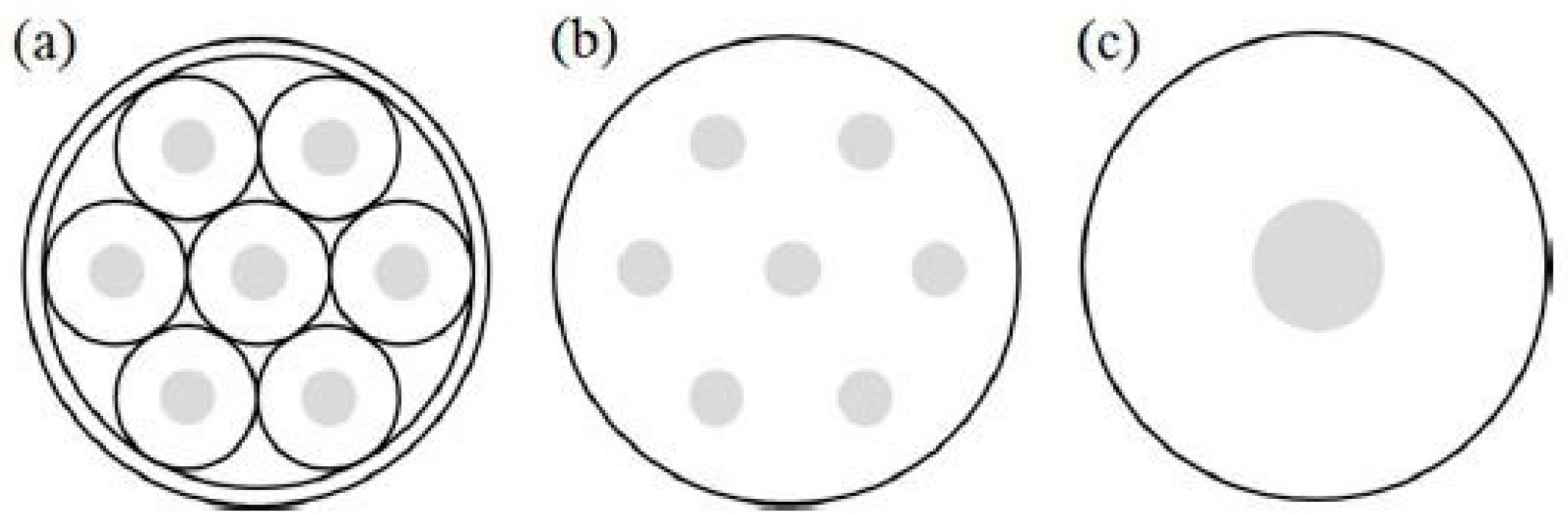
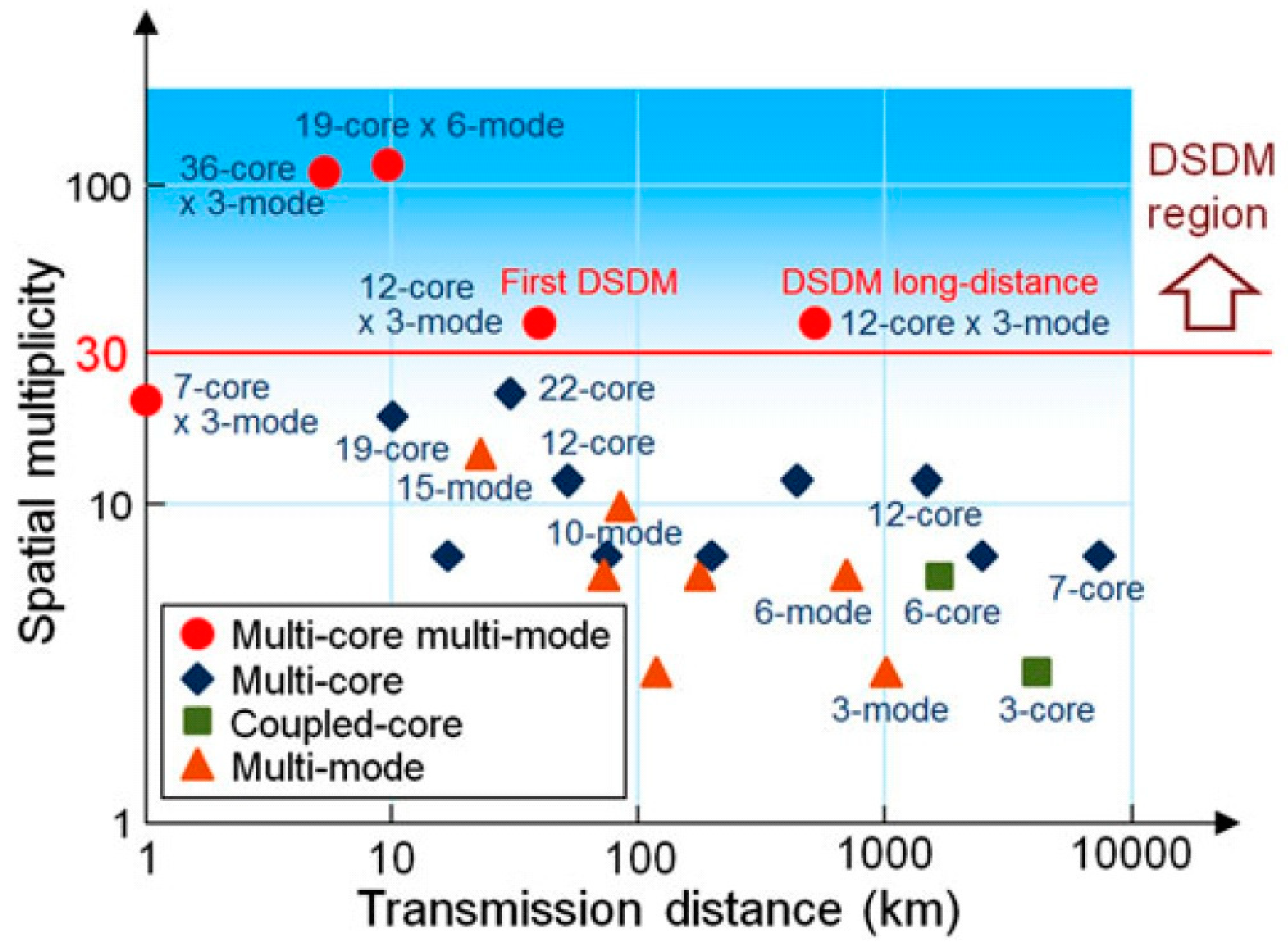
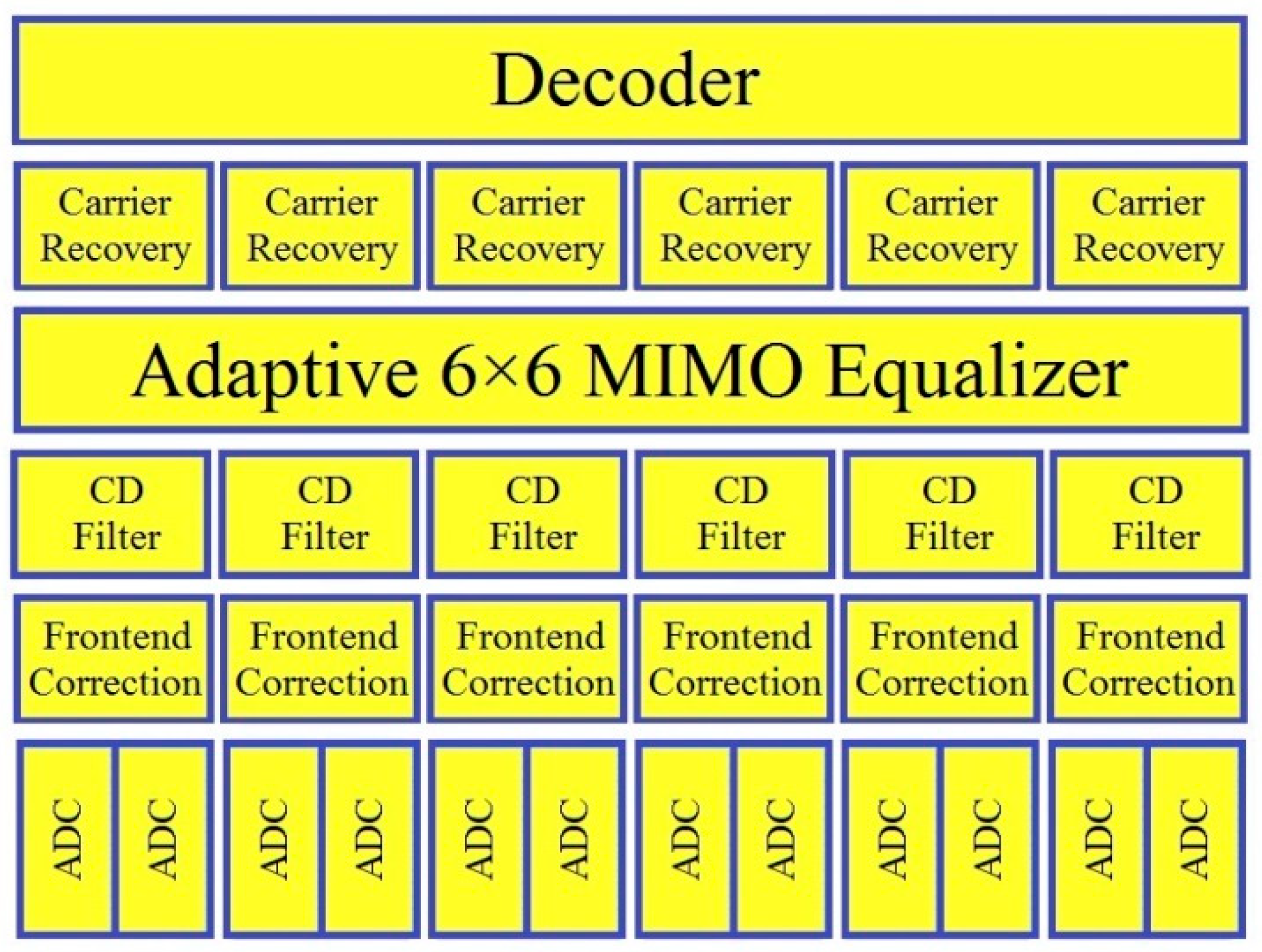
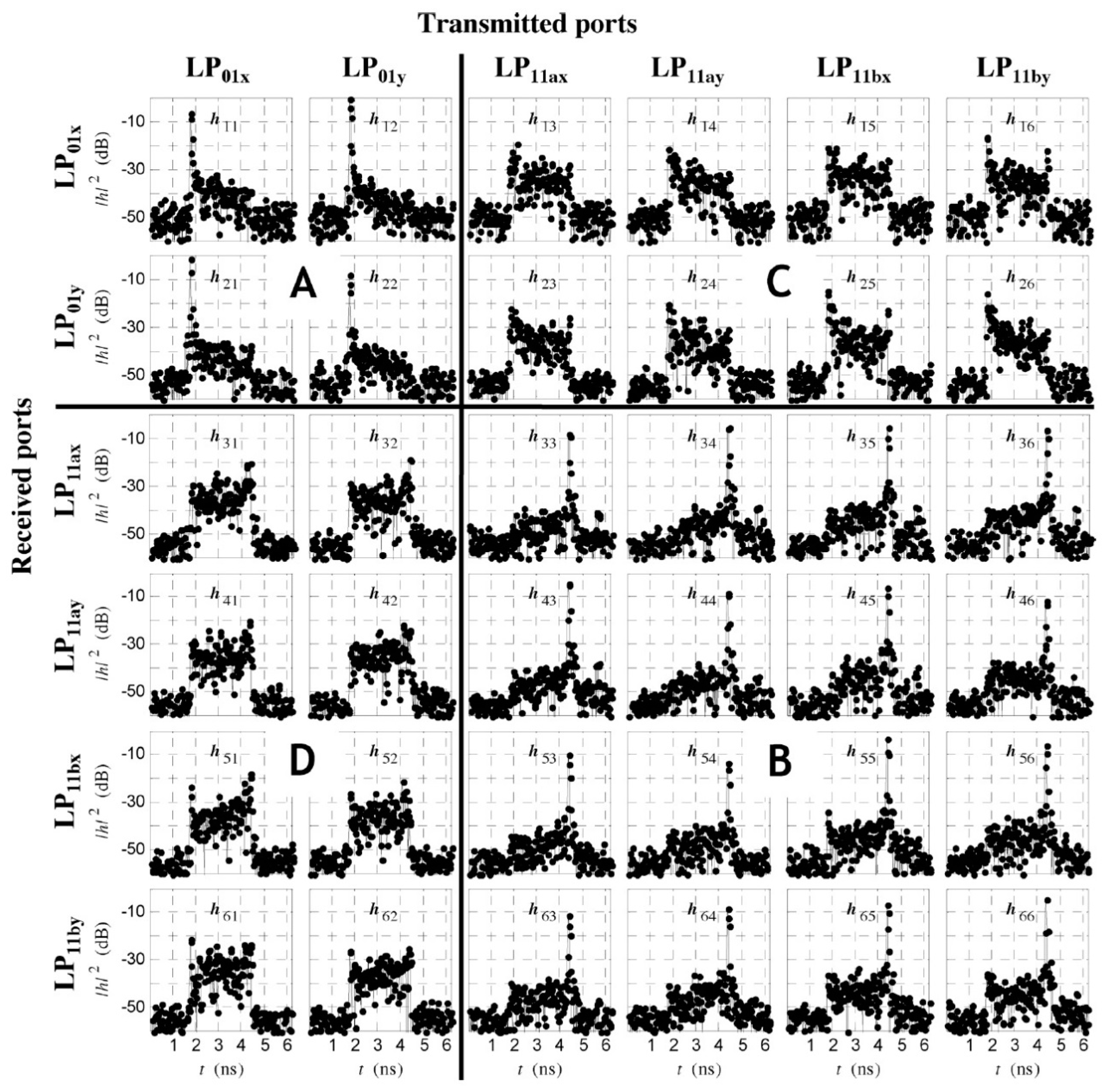

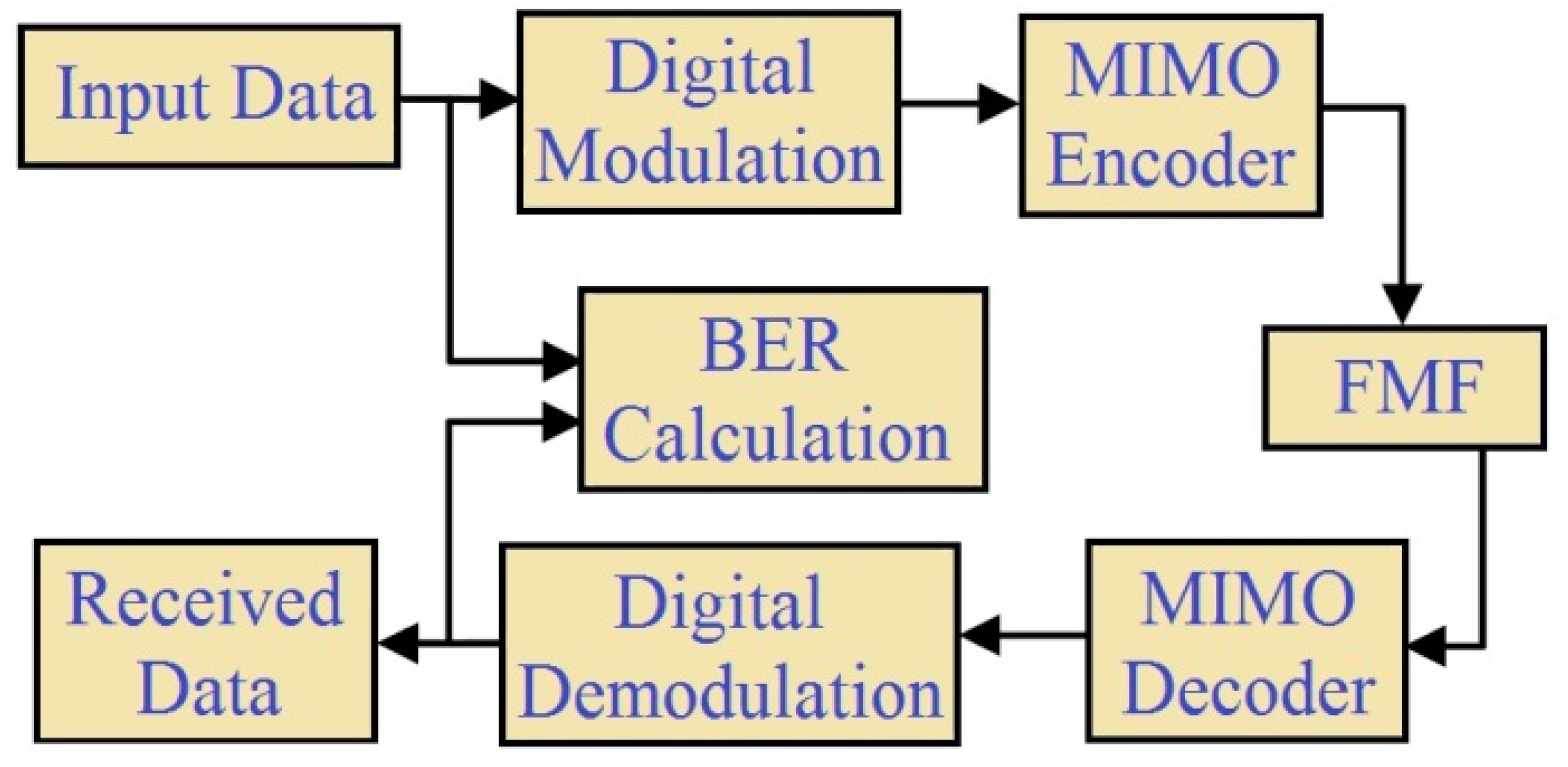


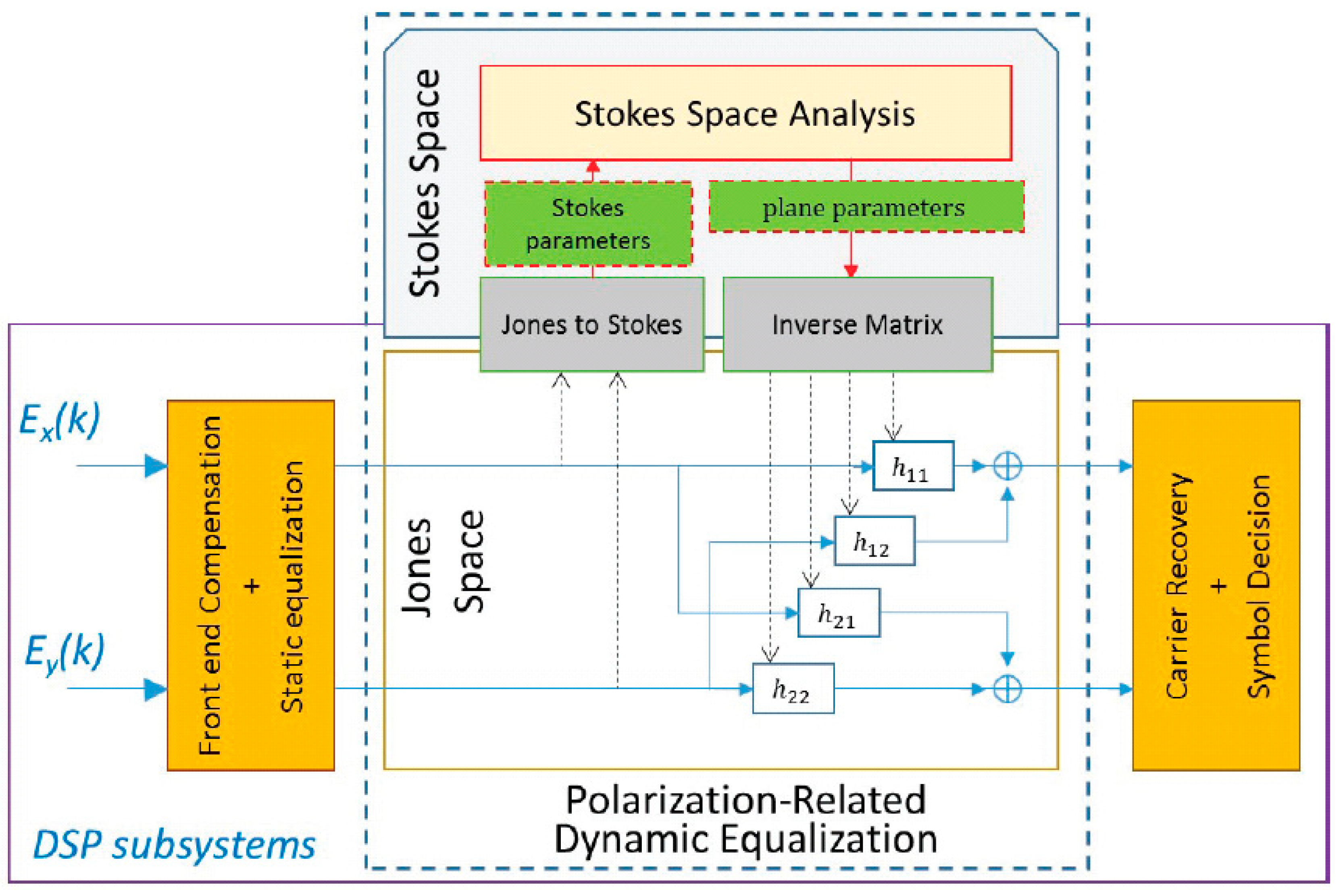
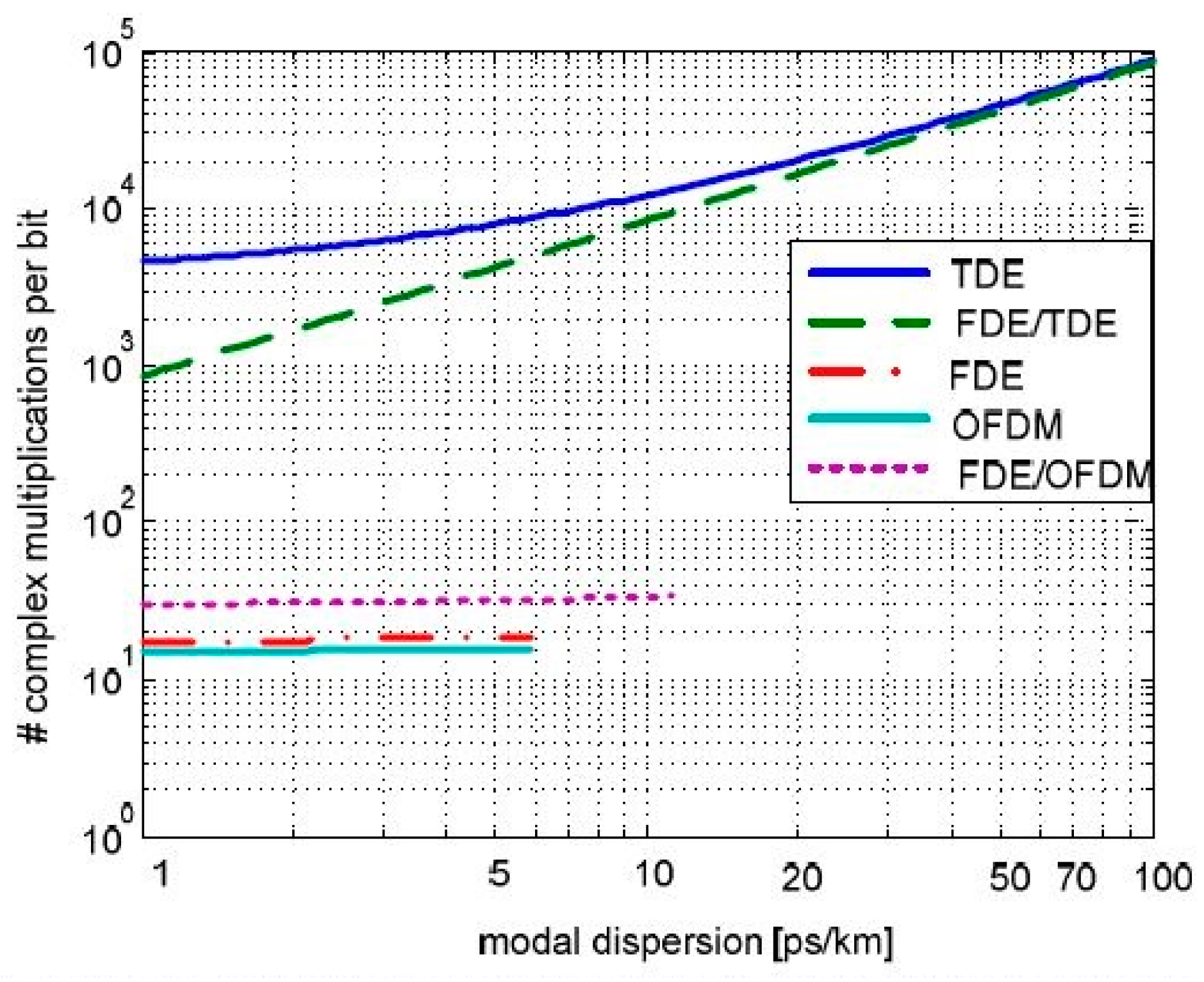



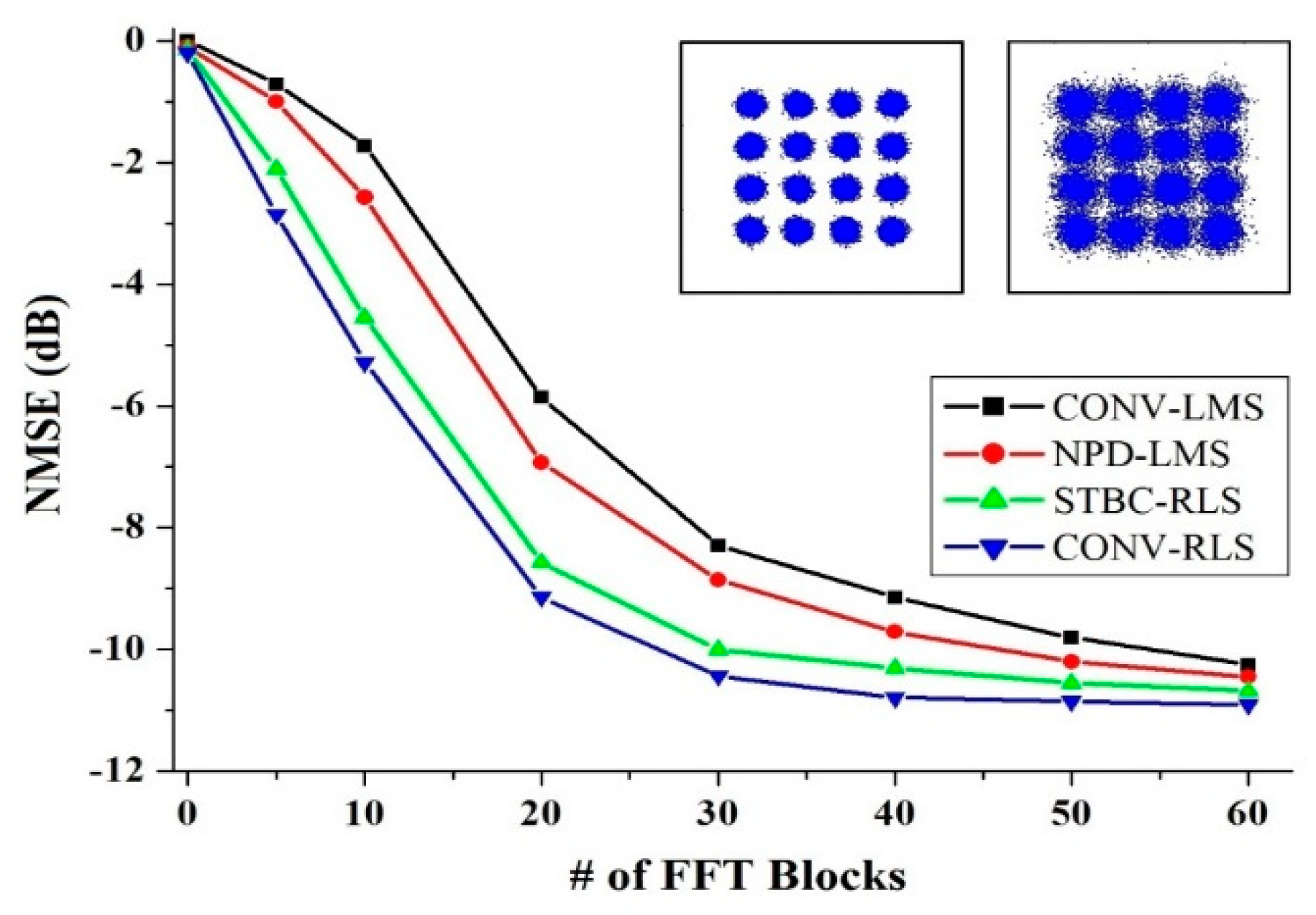
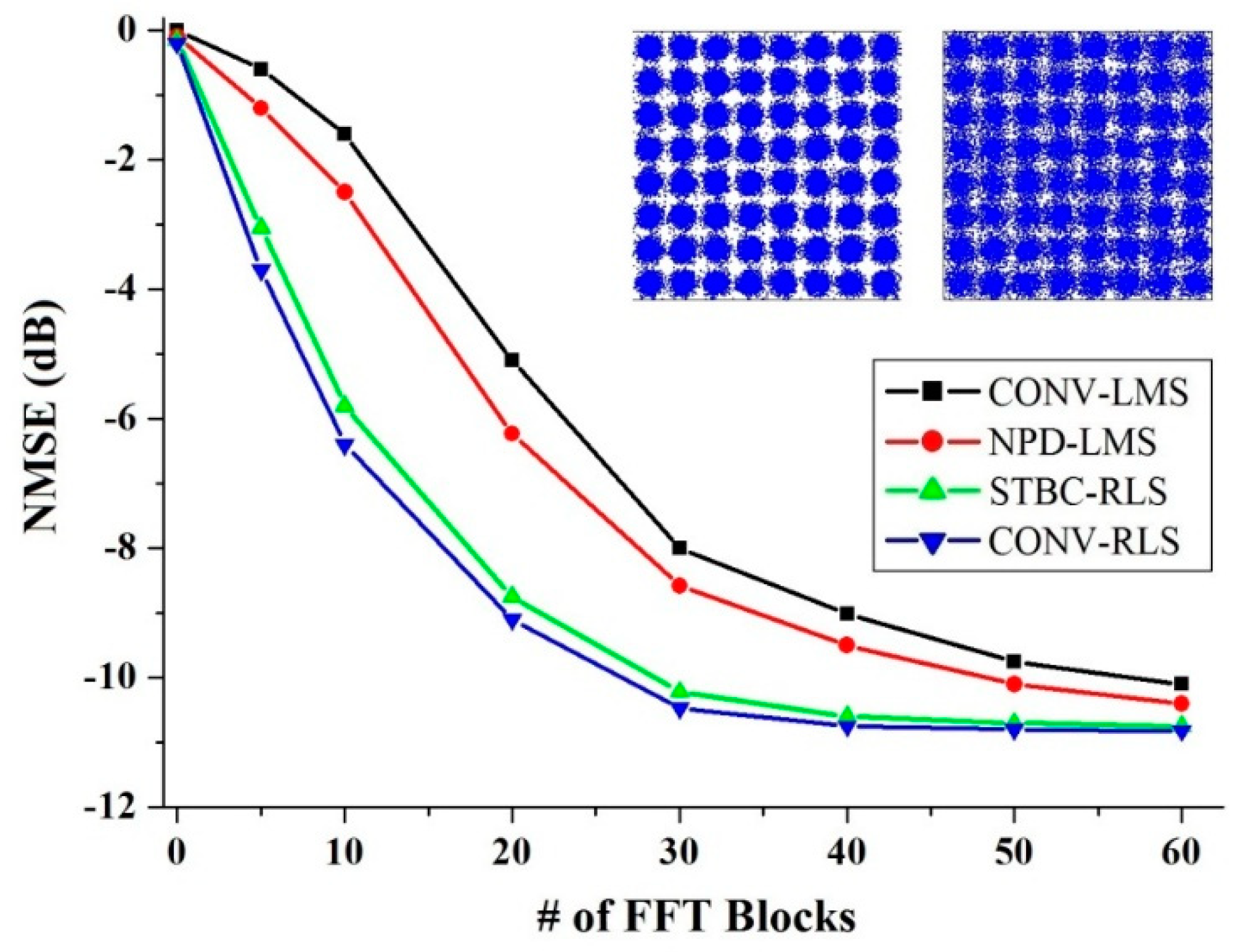
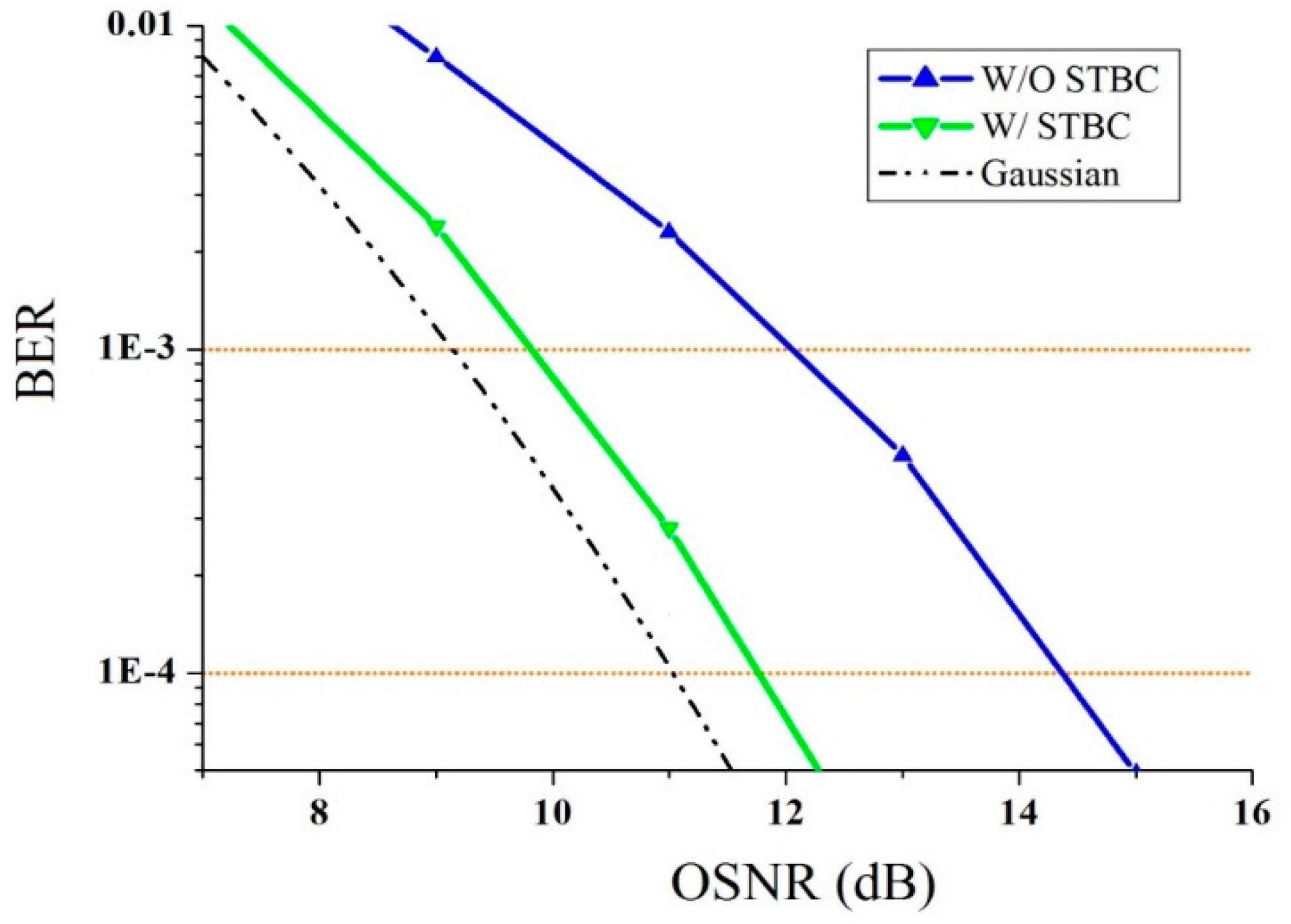

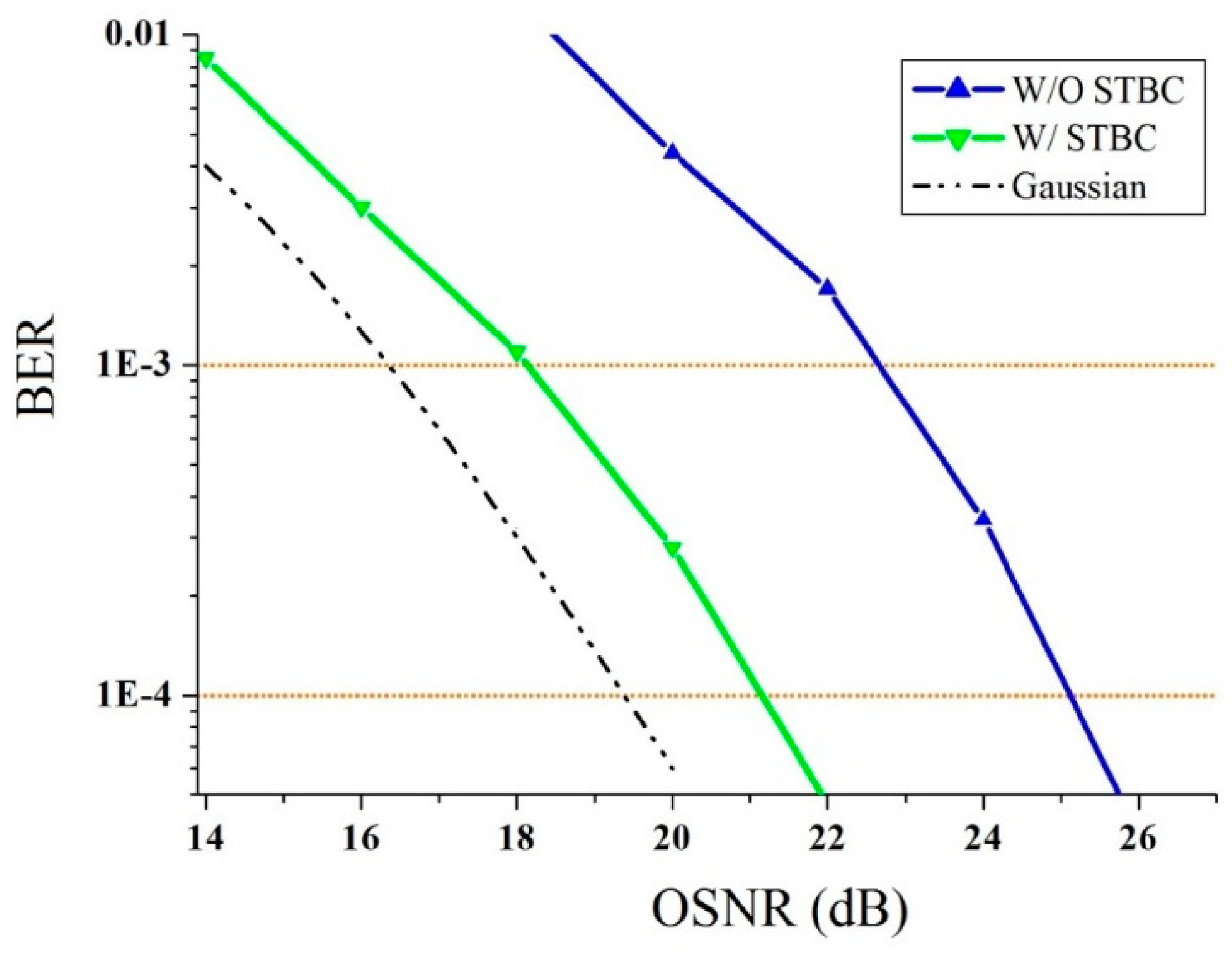
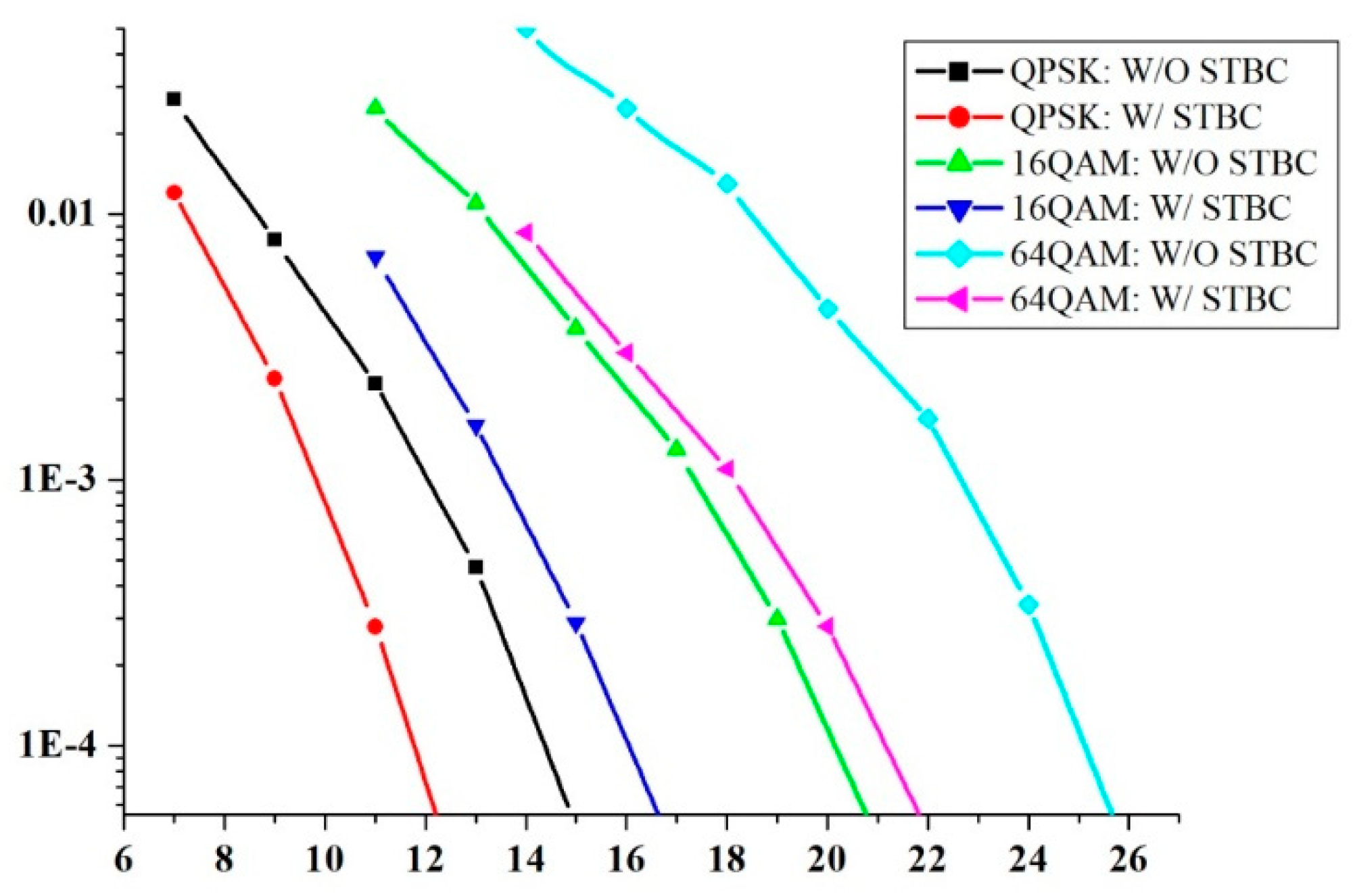
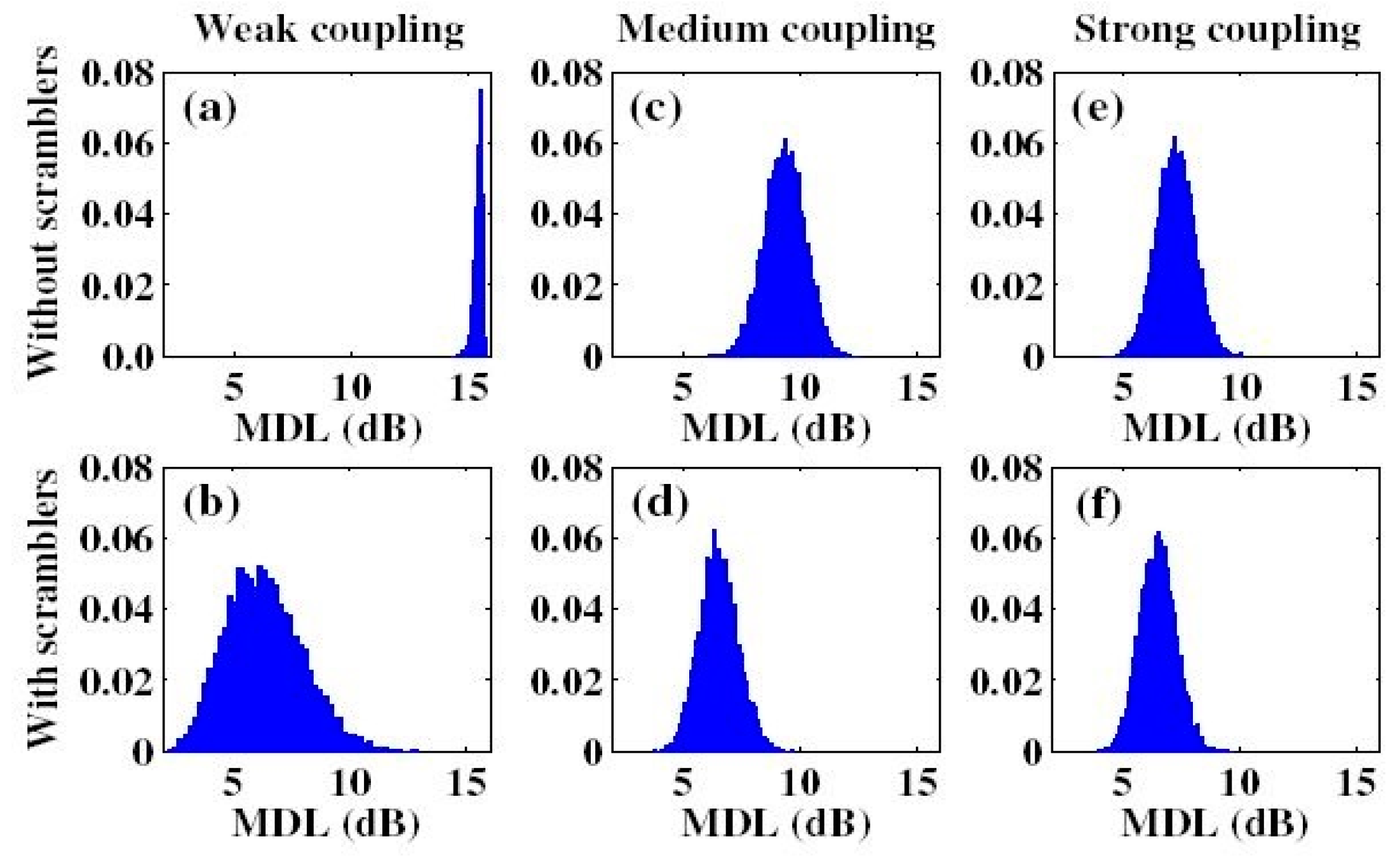
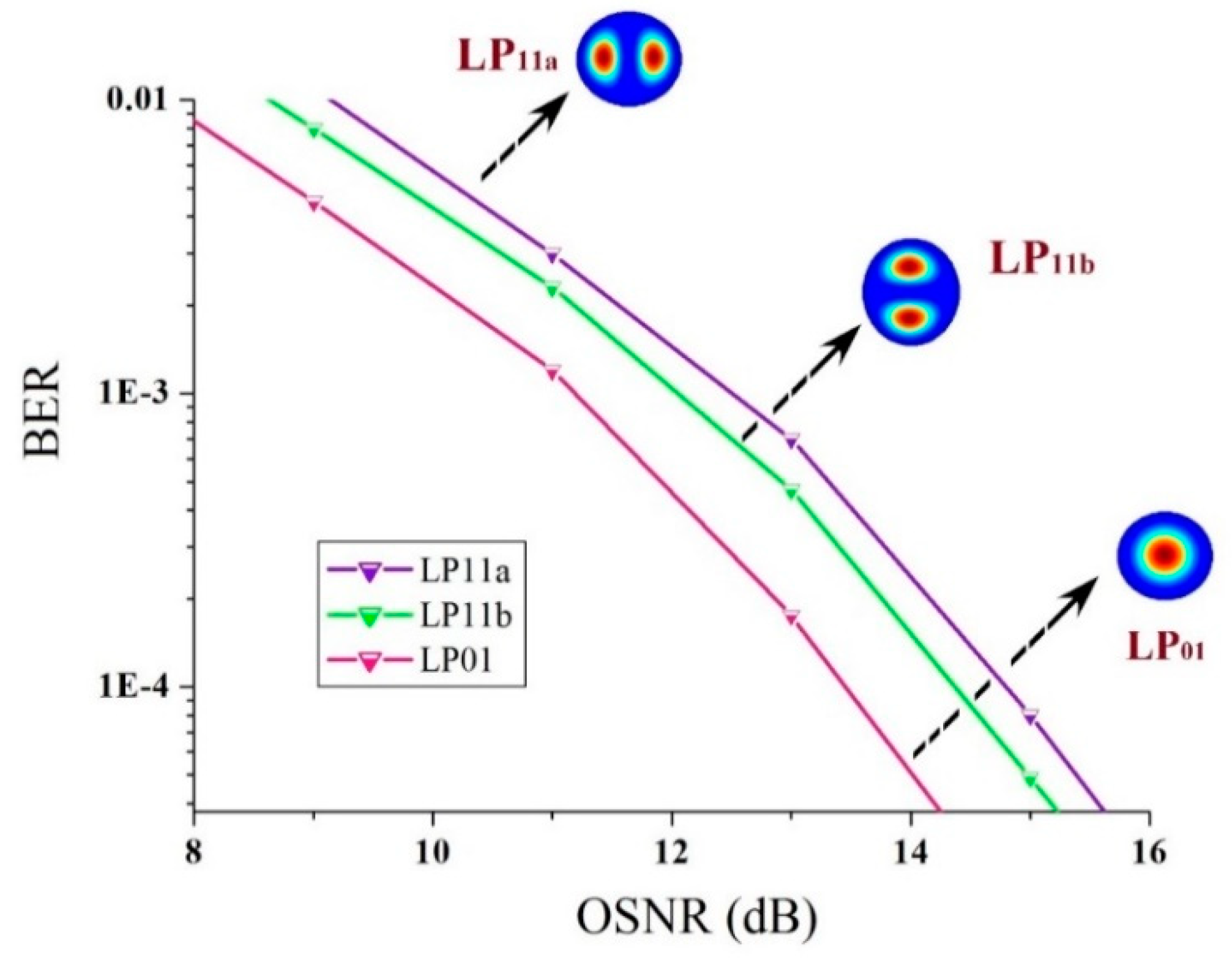

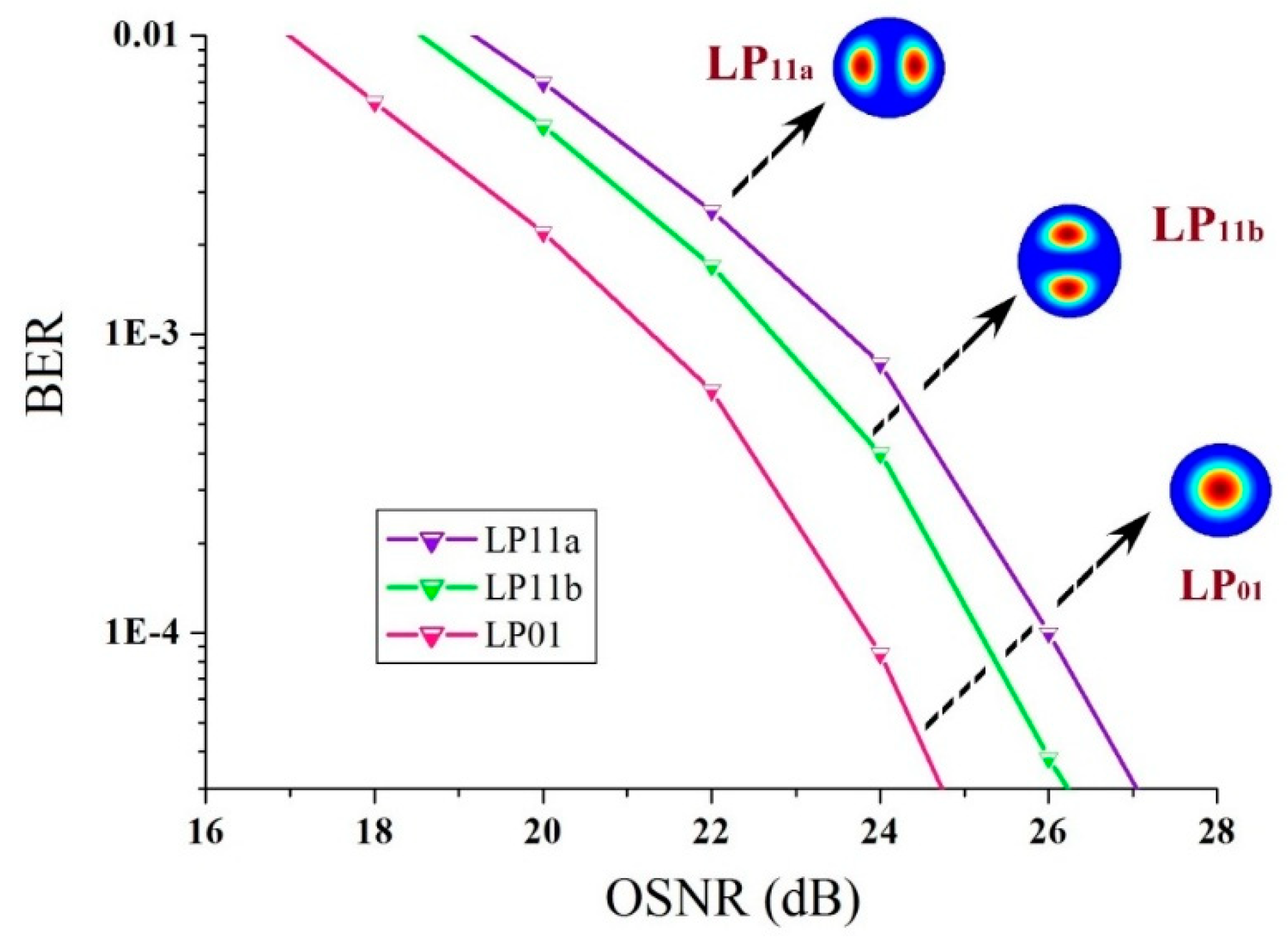
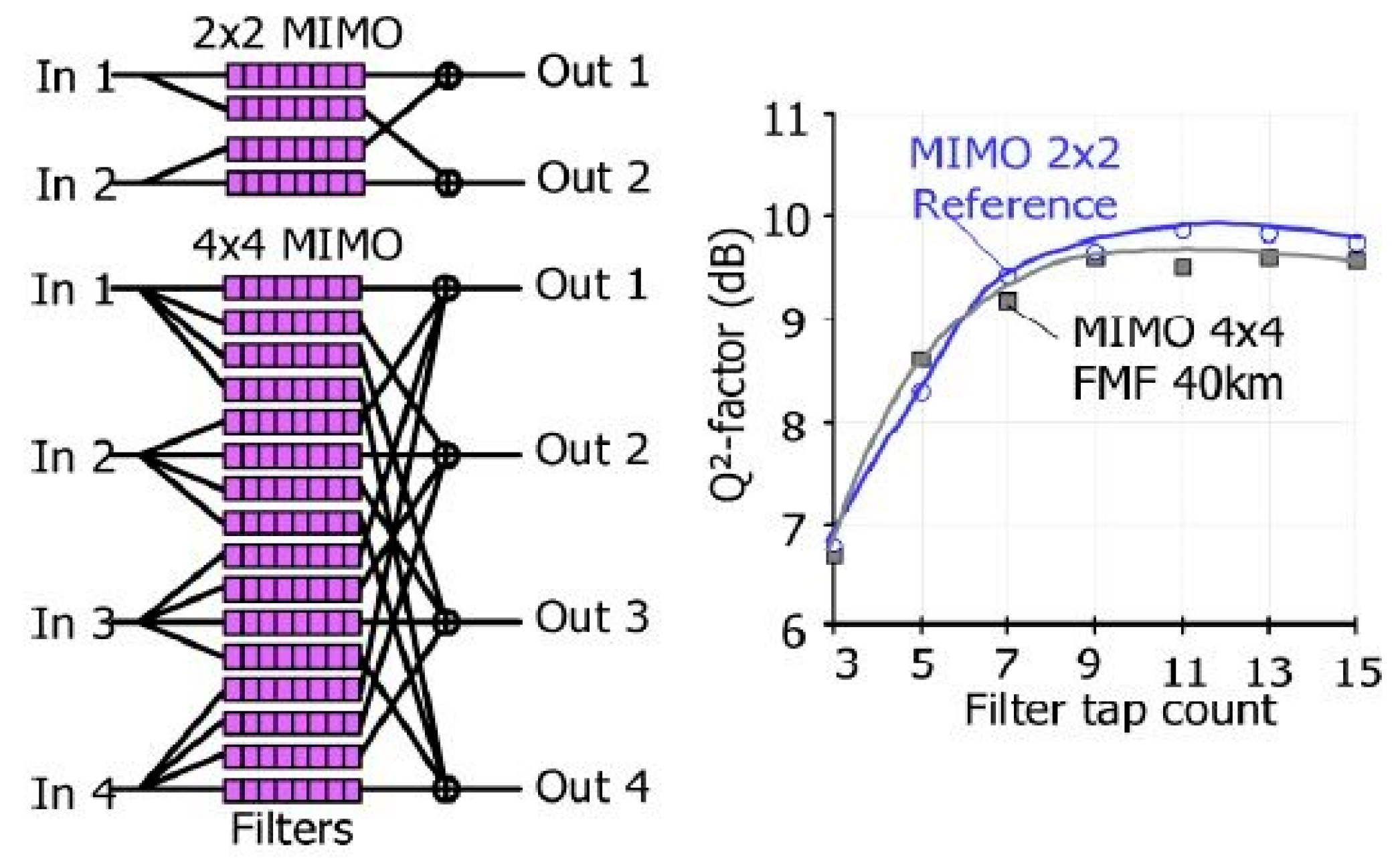
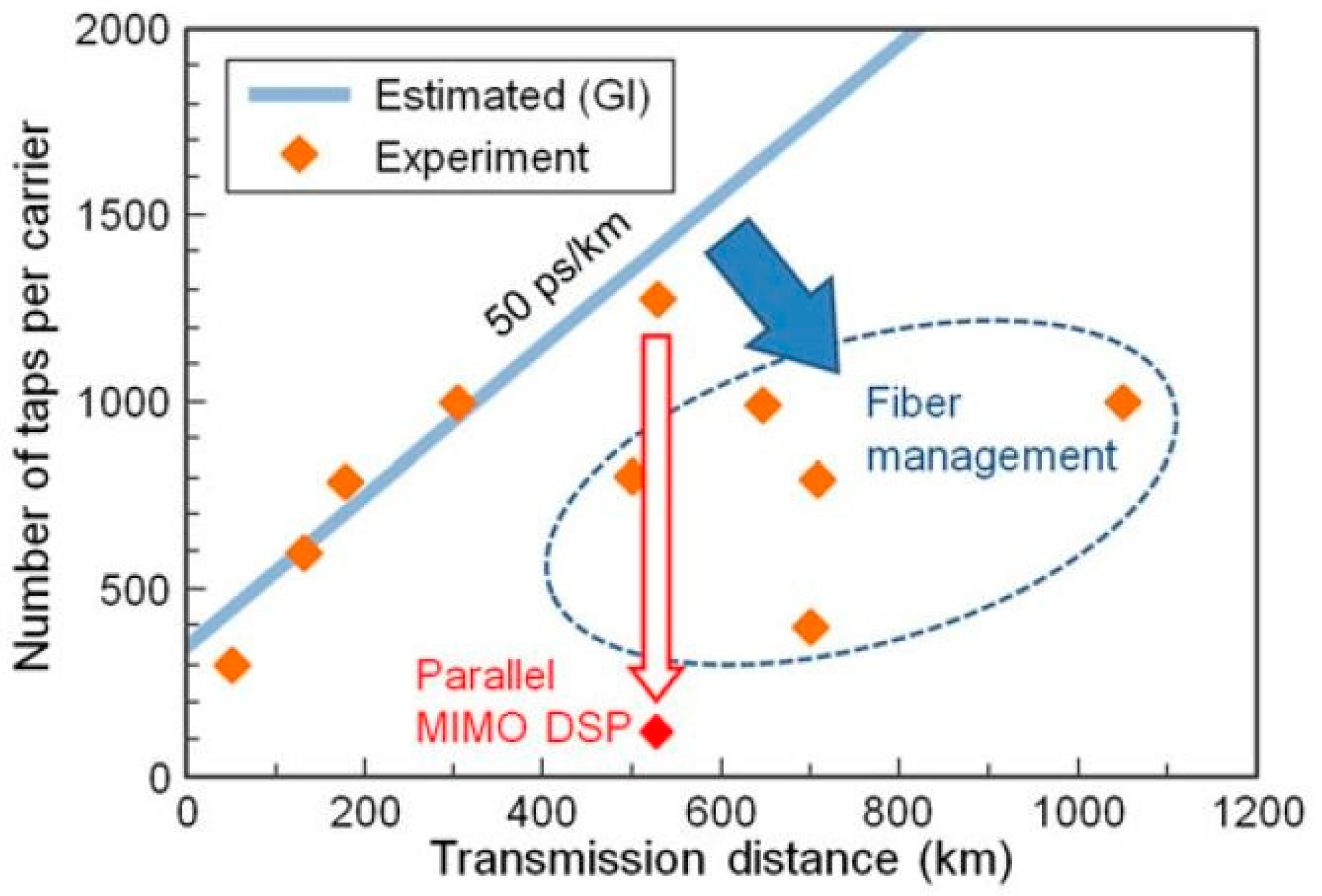
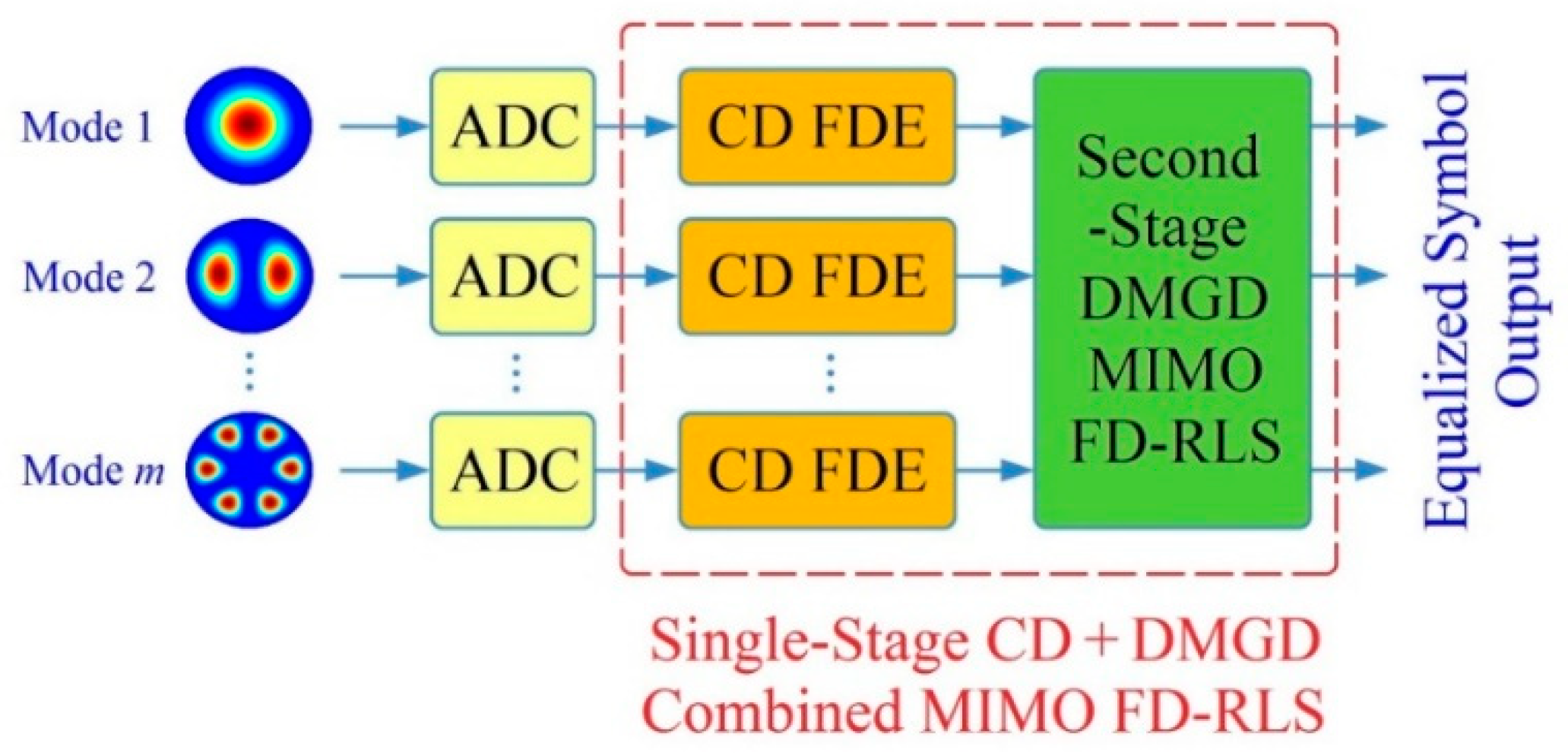
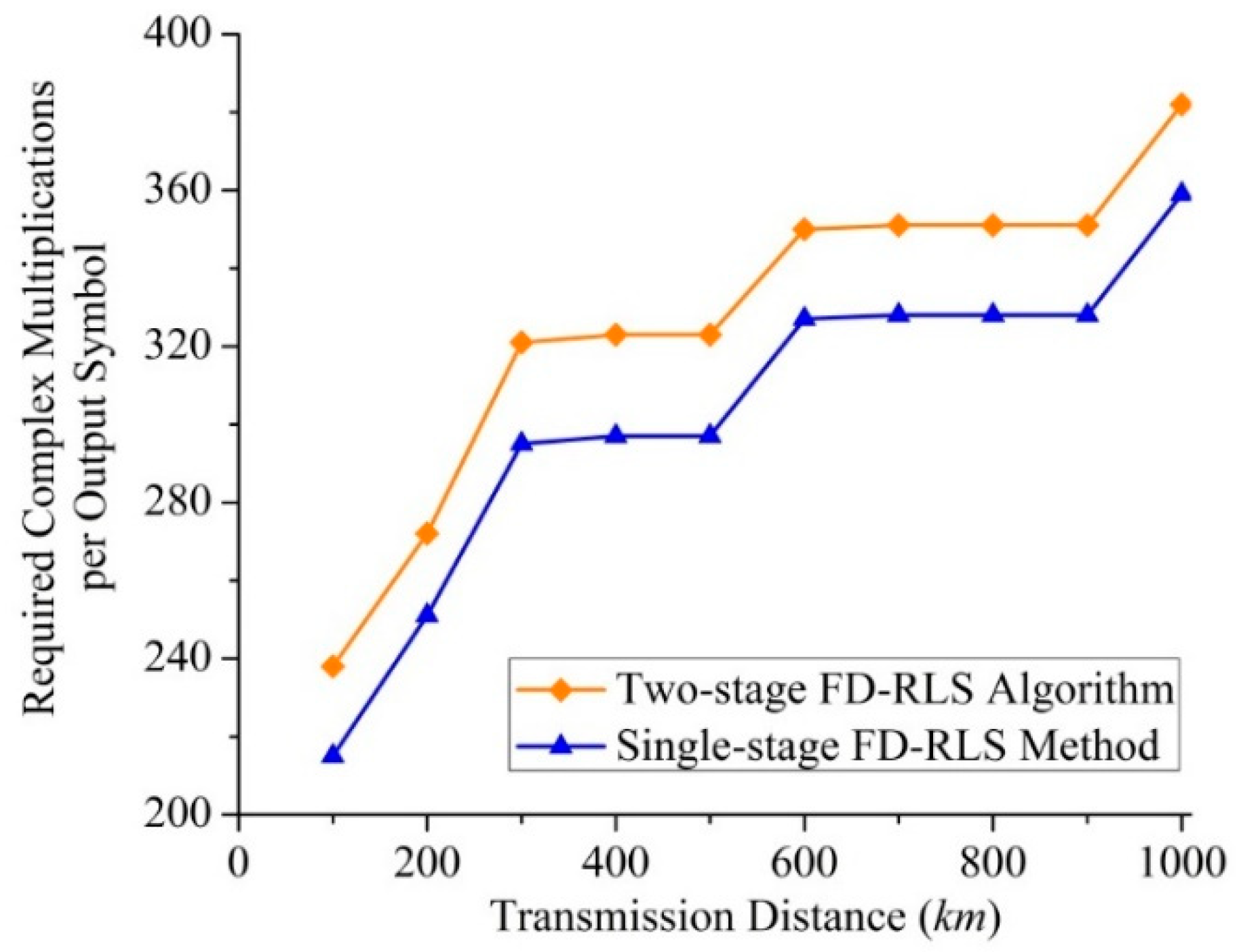
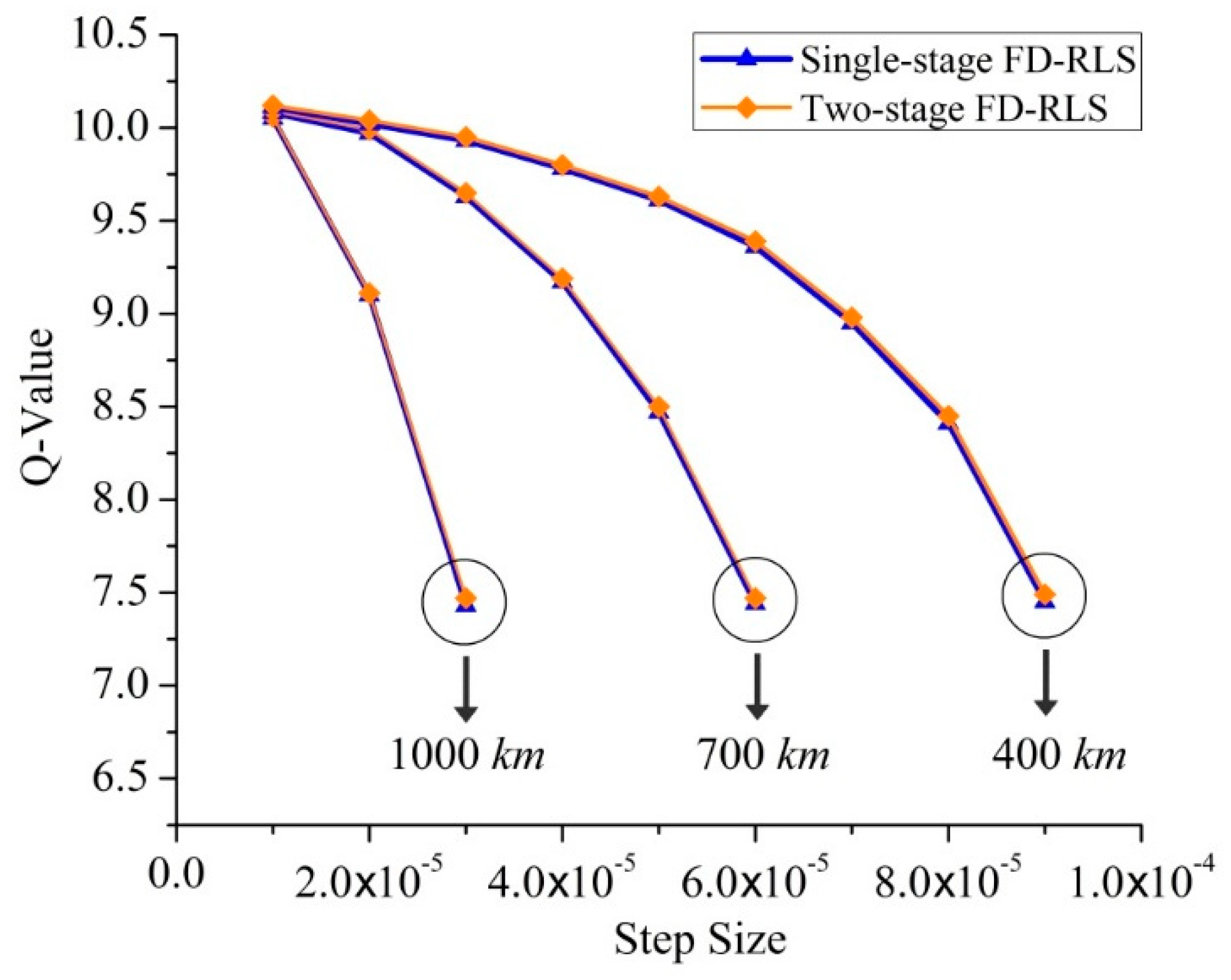

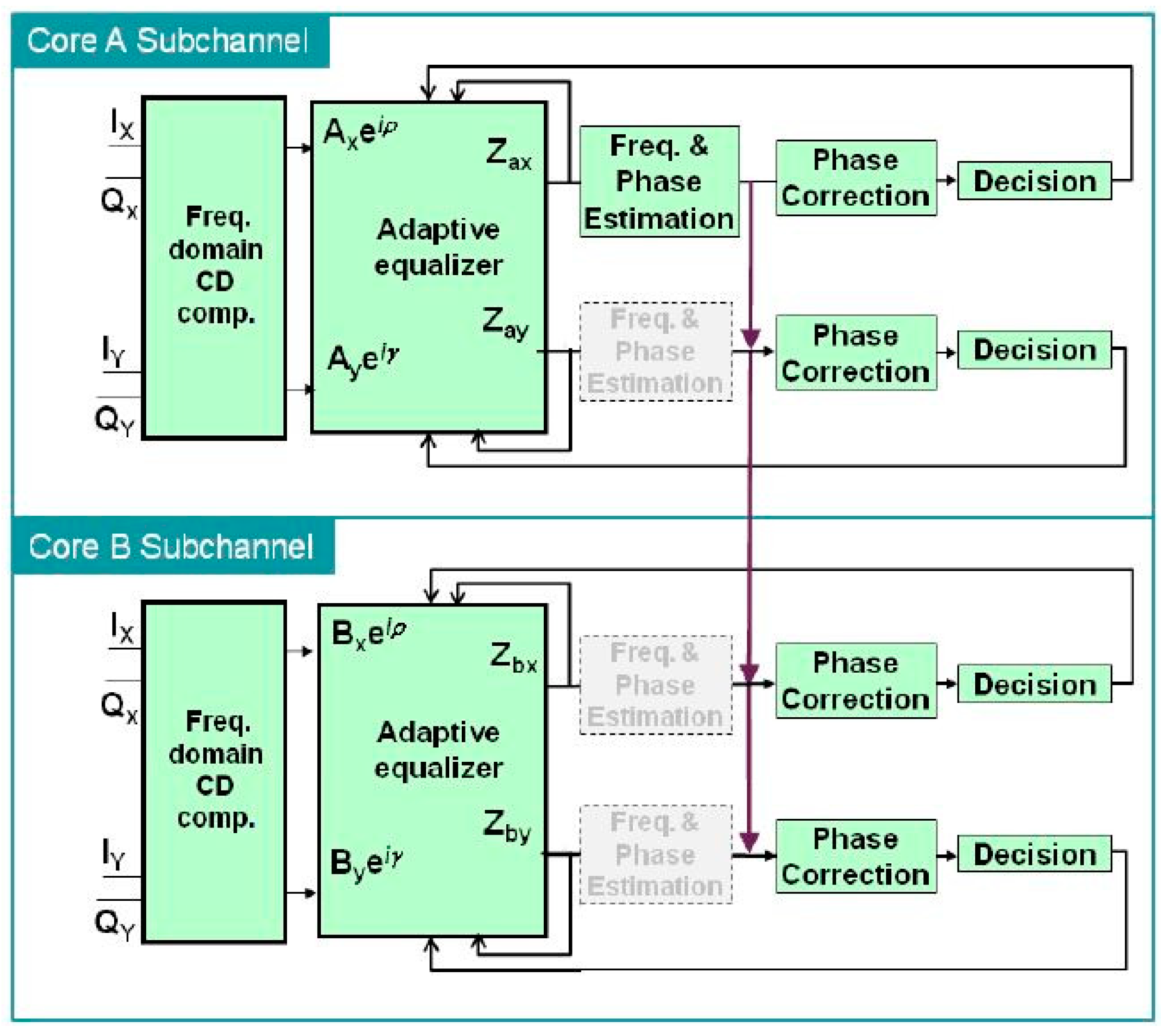
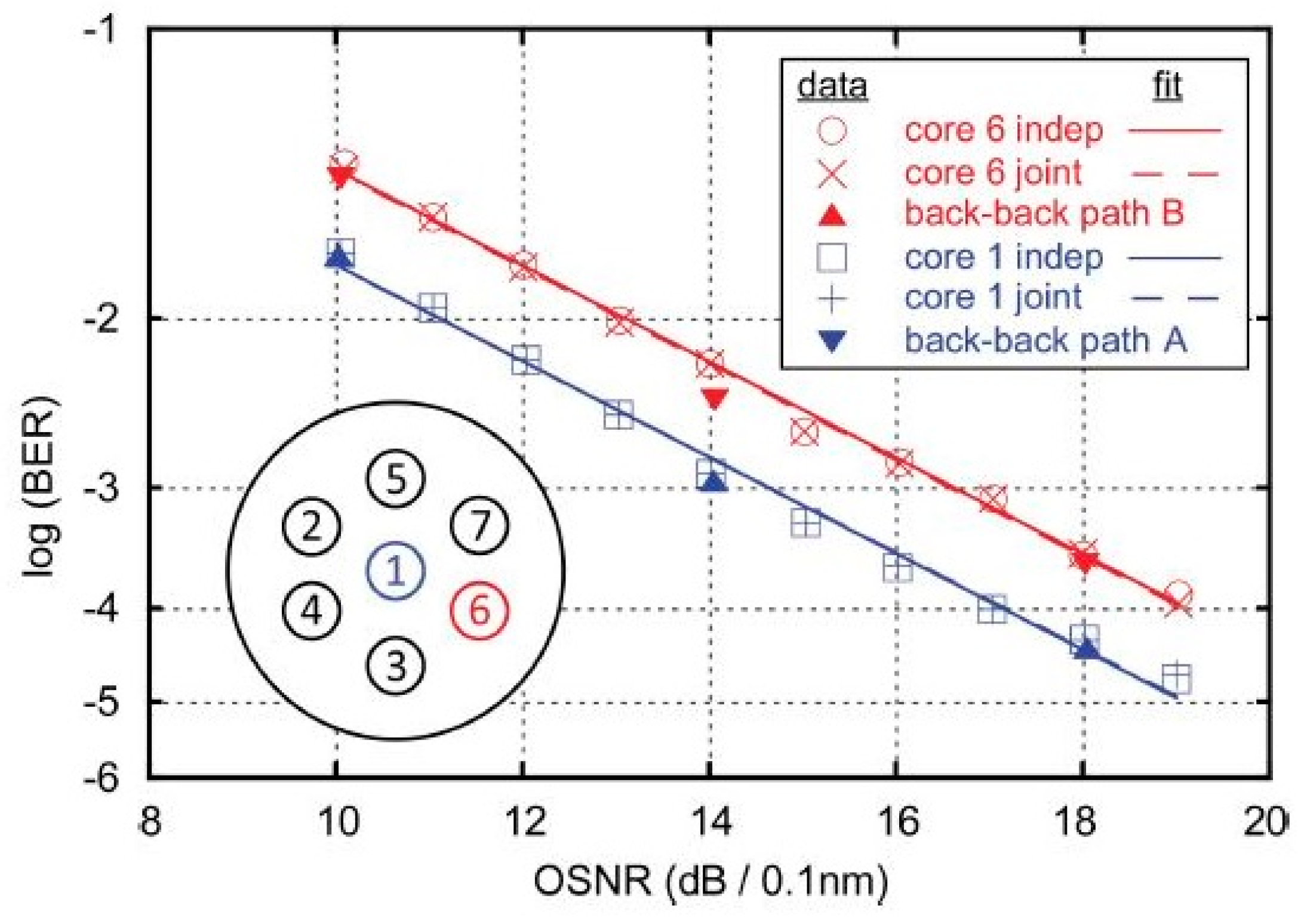
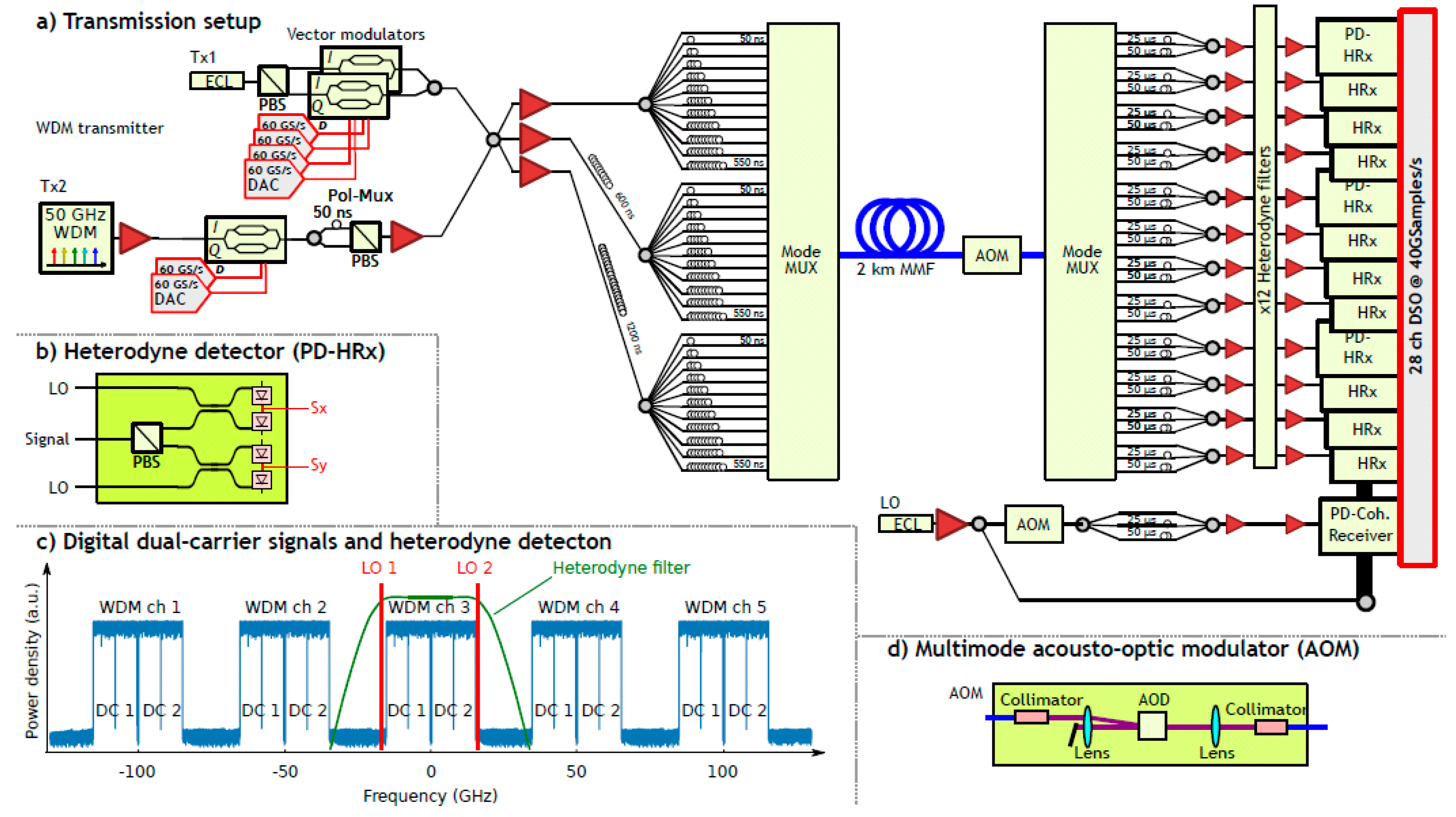
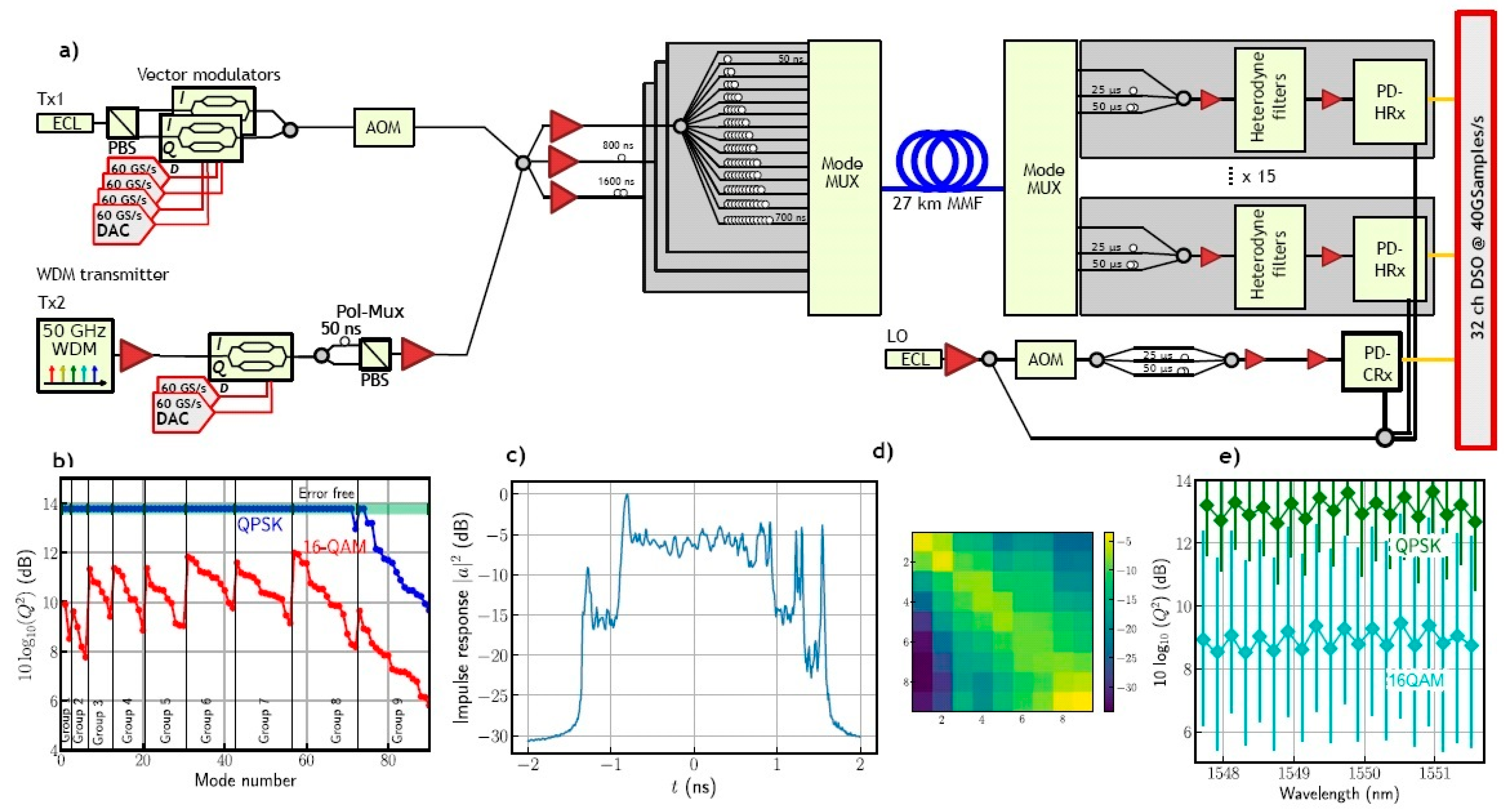
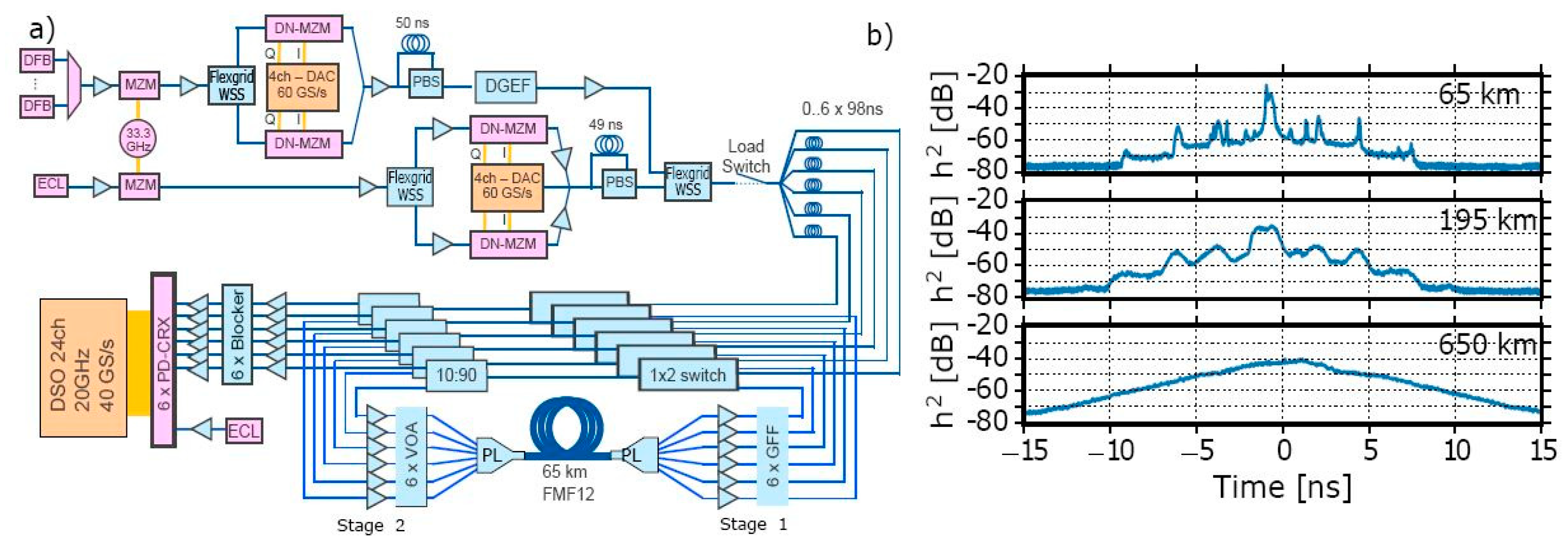

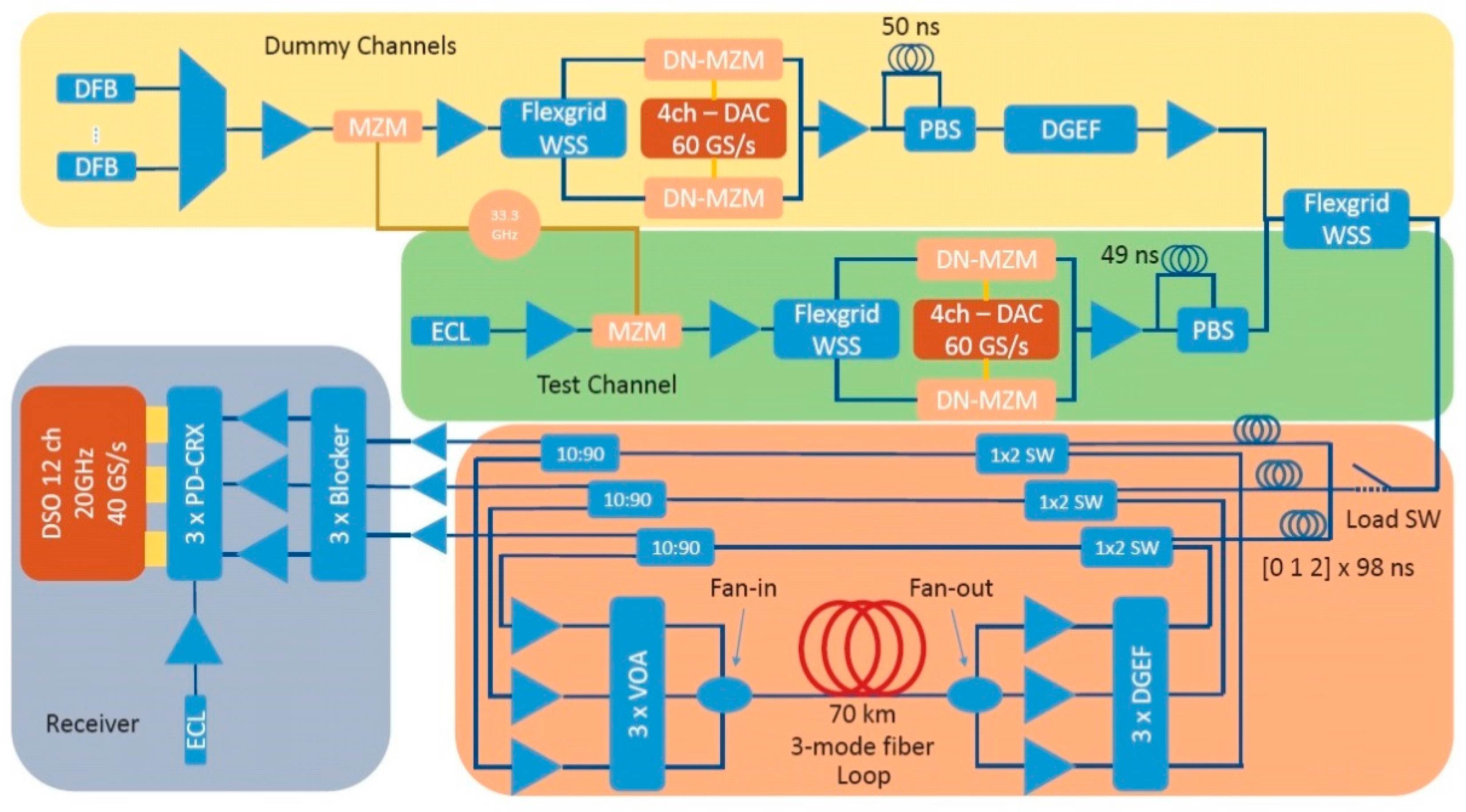
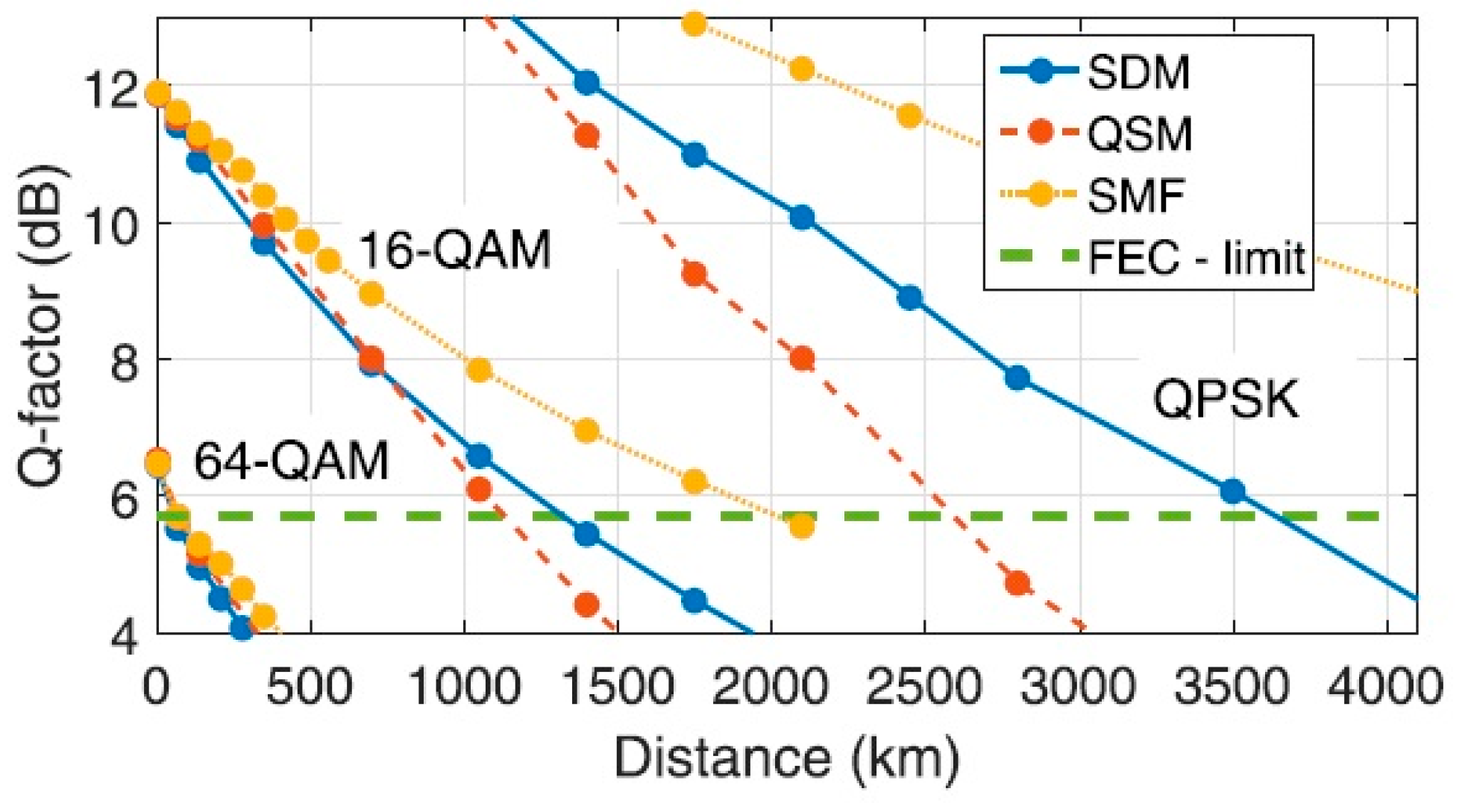
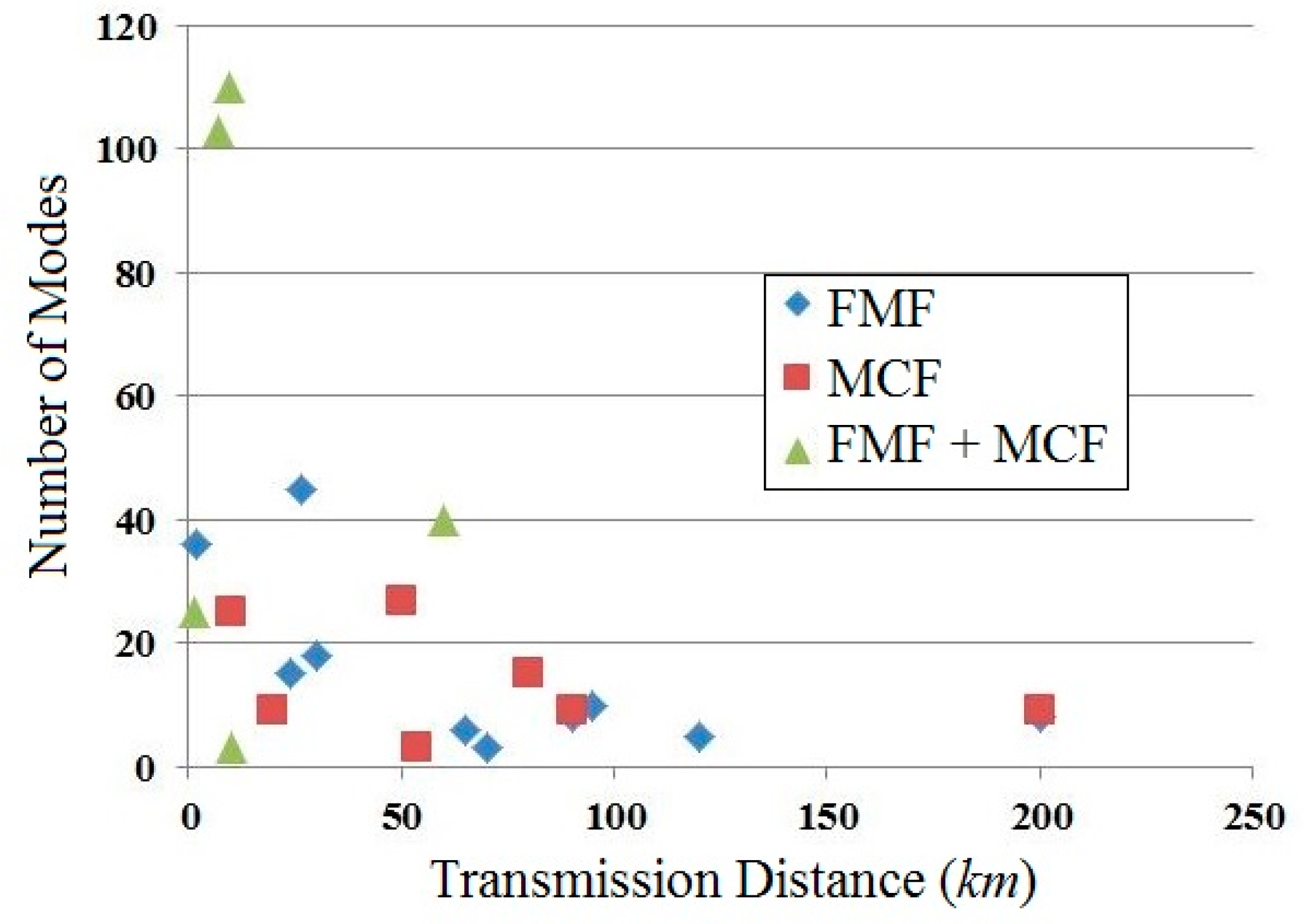
| Modulation Format | # of Symbols Transmitted | Levels per Carrier | # of Bits per Symbol Contained | Corresponding Data Rate |
|---|---|---|---|---|
| QPSK | 2 | 2 | 112 Gb/s | |
| 16QAM | 4 | 4 | 224 Gb/s | |
| 64QAM | 8 | 6 | 336 Gb/s |
| Transmission Distance | Spectral Efficiency | DSP Approach | Fiber Type | Number of Modes | Year | Reference |
|---|---|---|---|---|---|---|
| 2 km | 72 bit/s/Hz | 72 × 72 MIMO | 50 μm MMF | 36 × 2 | 2018 | [46] |
| 26.5 km | 202 bit/s/Hz | 90 × 90 MIMO | 50 μm MMF | 45 × 2 | 2018 | [47] |
| 65 km | 34.91 bit/s/Hz | 12 × 12 MIMO | FMF12 | 6 × 2 | 2017 | [48] |
| 70 km | 9 bit/s/Hz | 6 × 6 MIMO | FMF | 3 × 2 | 2017 | [49] |
| 9.8 km | 947 bit/s/Hz | 6 × 6 MIMO | FMF + MCF | 3 × 2 | 2016 | [51] |
| 23.8 km | 43.63 bit/s/Hz | 30 × 30 MIMO | FMF9 | 15 × 2 | 2015 | [52] |
| 53.7 km | 217.6 bit/s/Hz | 6 × 6 MIMO | MCF | 3 × 2 | 2016 | [53] |
© 2019 by the authors. Licensee MDPI, Basel, Switzerland. This article is an open access article distributed under the terms and conditions of the Creative Commons Attribution (CC BY) license (http://creativecommons.org/licenses/by/4.0/).
Share and Cite
Weng, Y.; Wang, J.; Pan, Z. Recent Advances in DSP Techniques for Mode Division Multiplexing Optical Networks with MIMO Equalization: A Review. Appl. Sci. 2019, 9, 1178. https://doi.org/10.3390/app9061178
Weng Y, Wang J, Pan Z. Recent Advances in DSP Techniques for Mode Division Multiplexing Optical Networks with MIMO Equalization: A Review. Applied Sciences. 2019; 9(6):1178. https://doi.org/10.3390/app9061178
Chicago/Turabian StyleWeng, Yi, Junyi Wang, and Zhongqi Pan. 2019. "Recent Advances in DSP Techniques for Mode Division Multiplexing Optical Networks with MIMO Equalization: A Review" Applied Sciences 9, no. 6: 1178. https://doi.org/10.3390/app9061178
APA StyleWeng, Y., Wang, J., & Pan, Z. (2019). Recent Advances in DSP Techniques for Mode Division Multiplexing Optical Networks with MIMO Equalization: A Review. Applied Sciences, 9(6), 1178. https://doi.org/10.3390/app9061178






